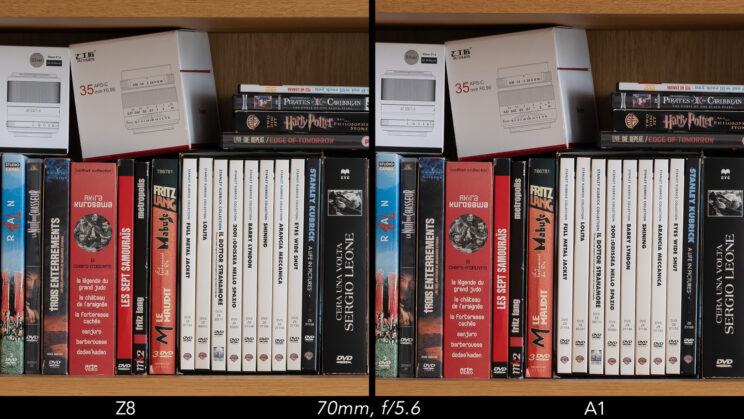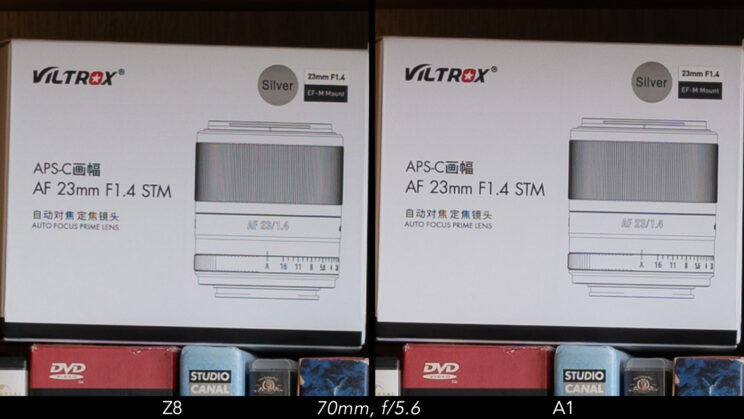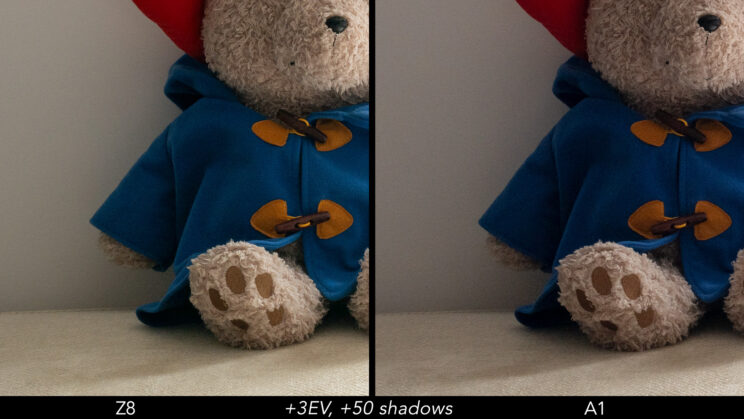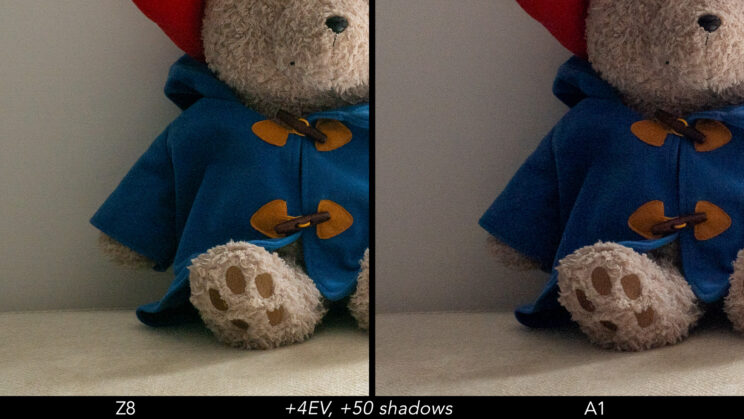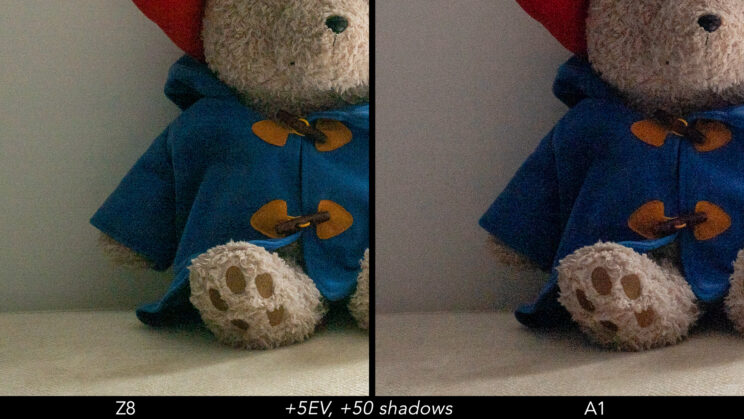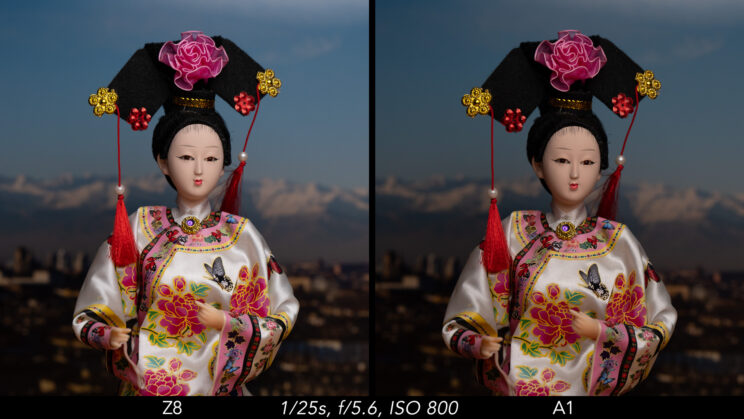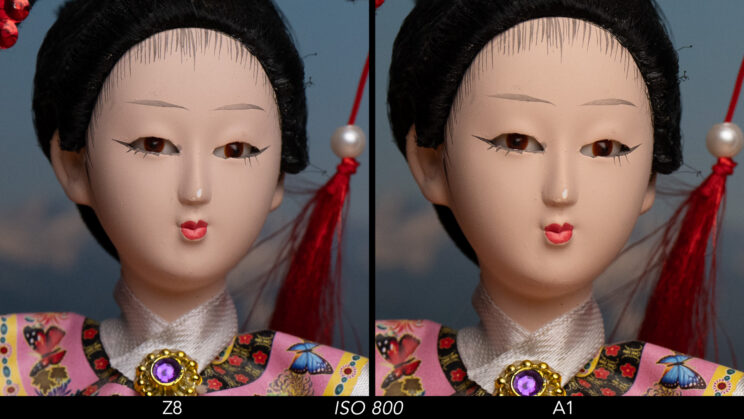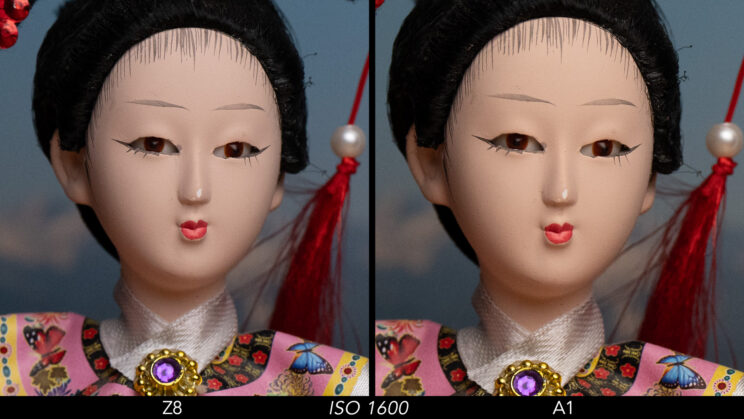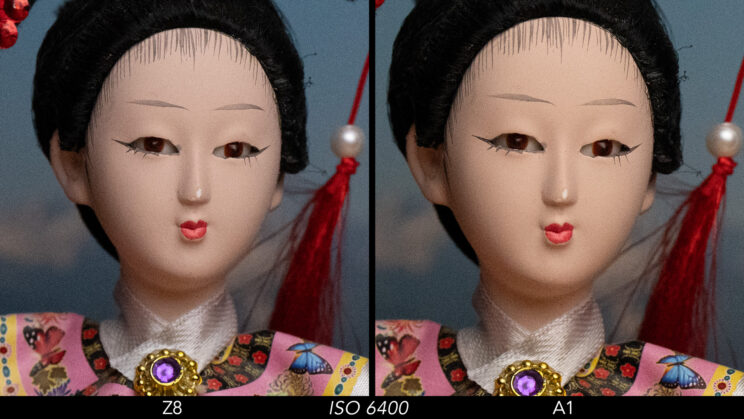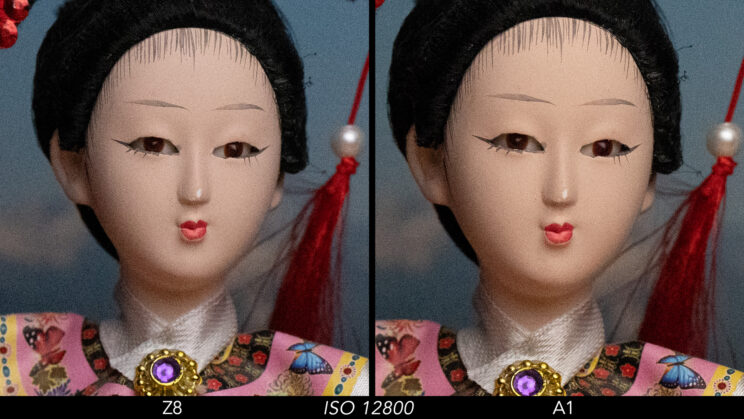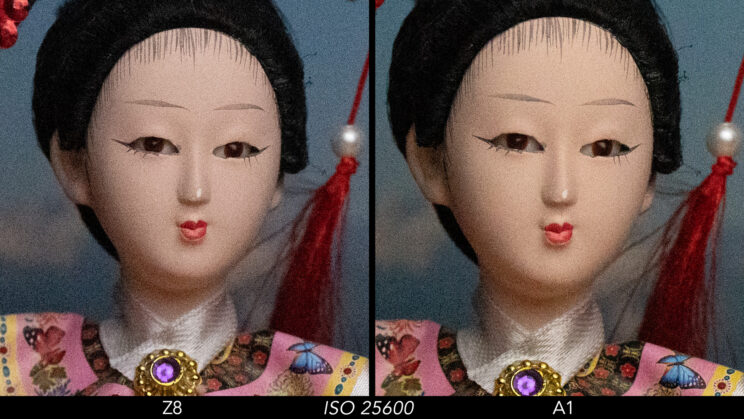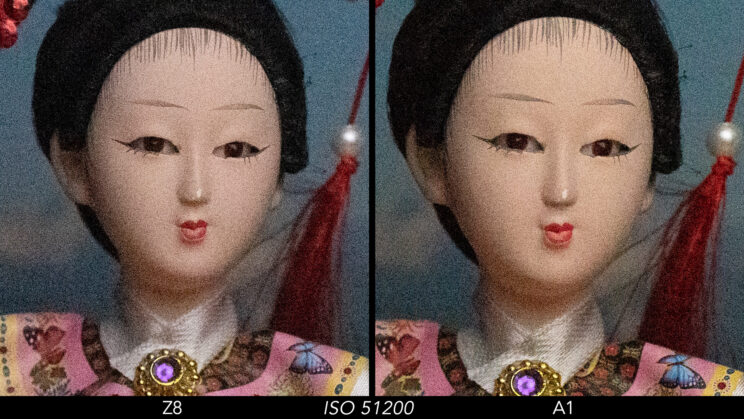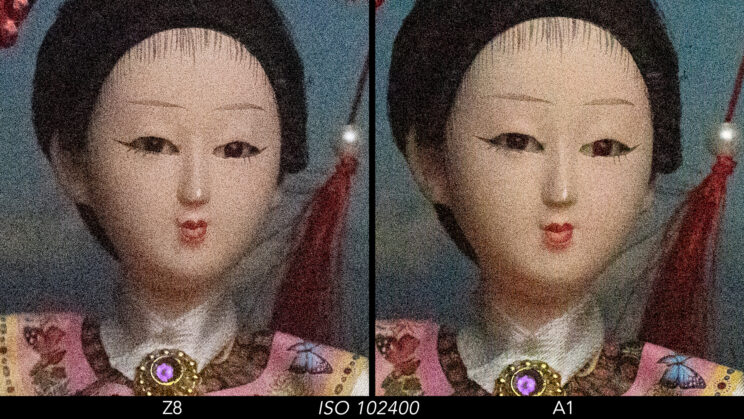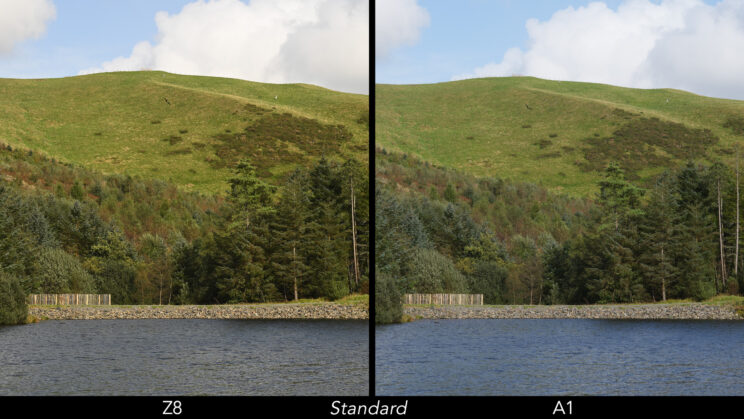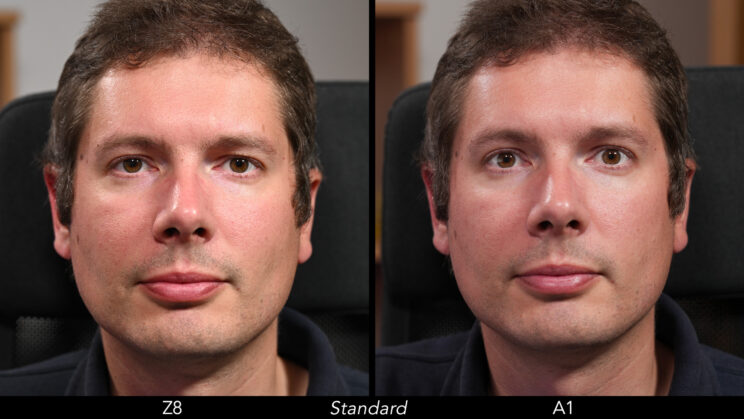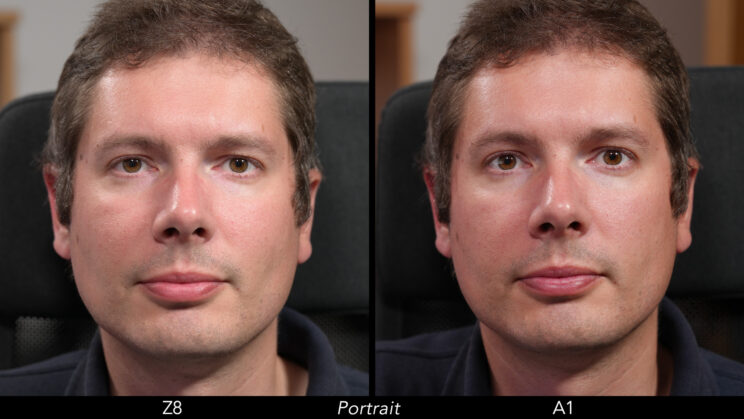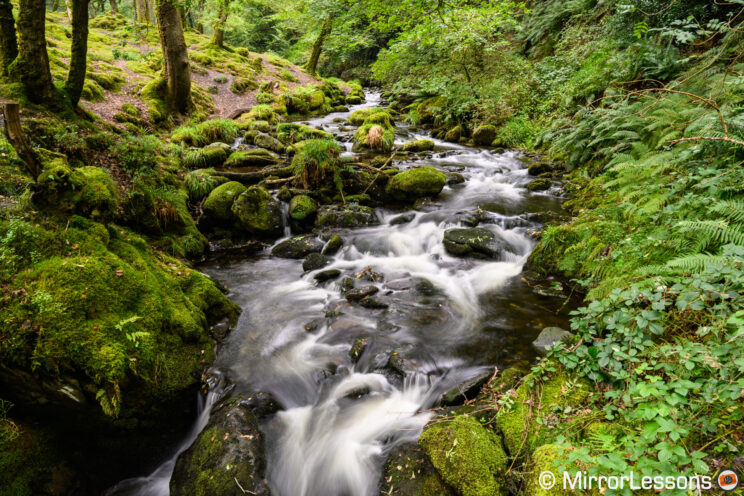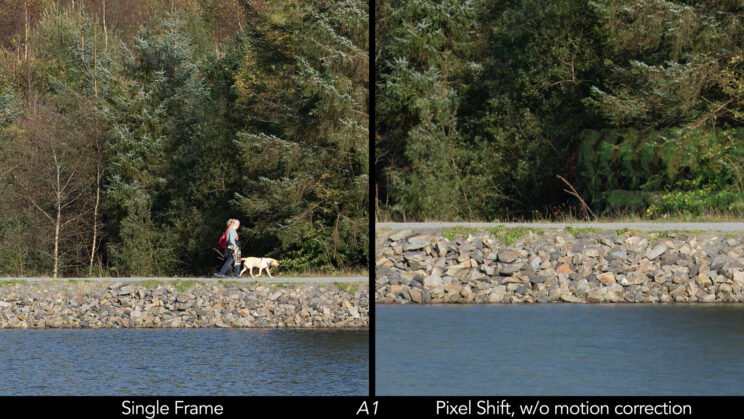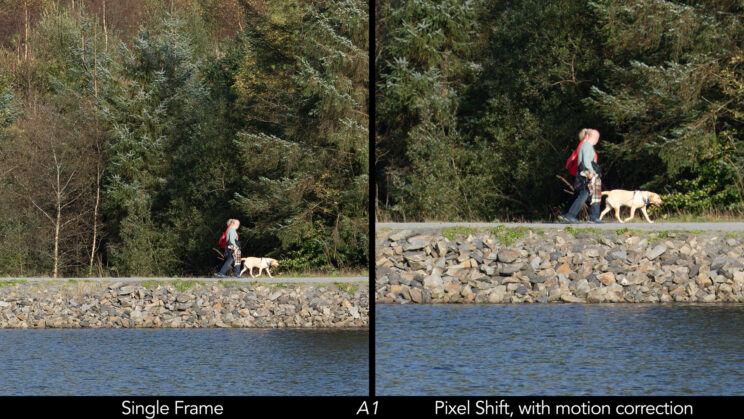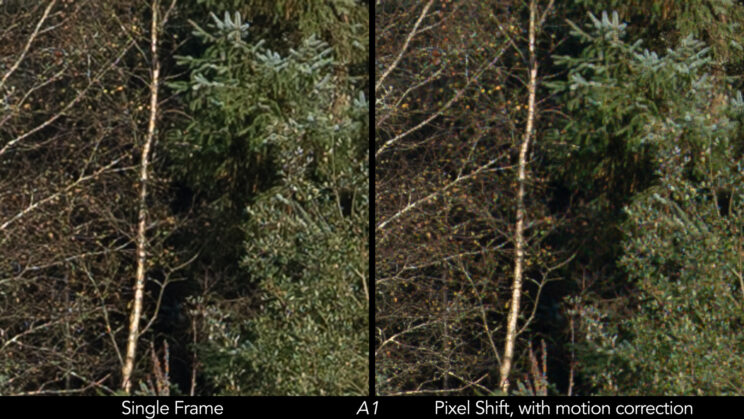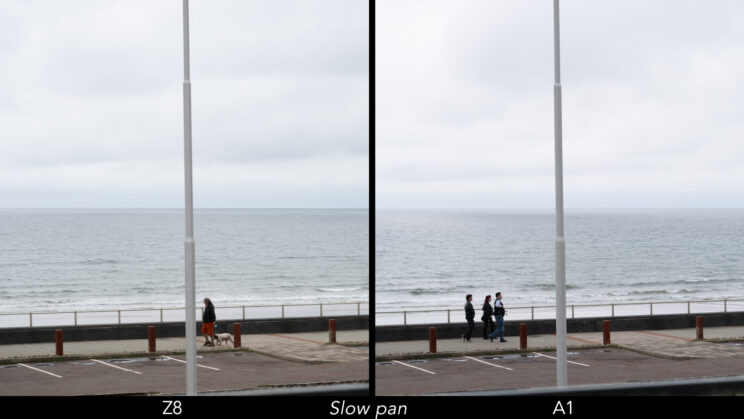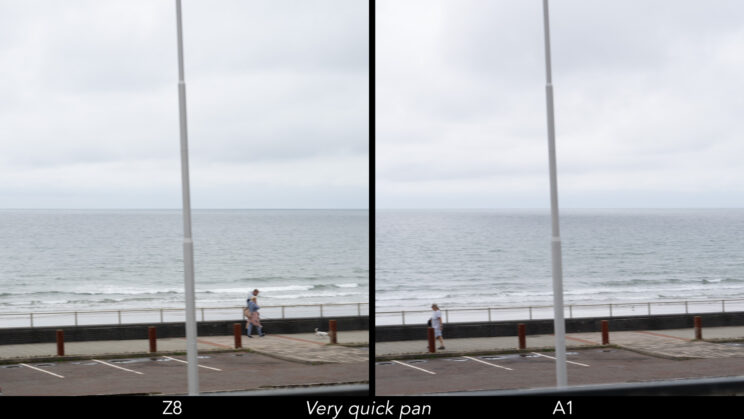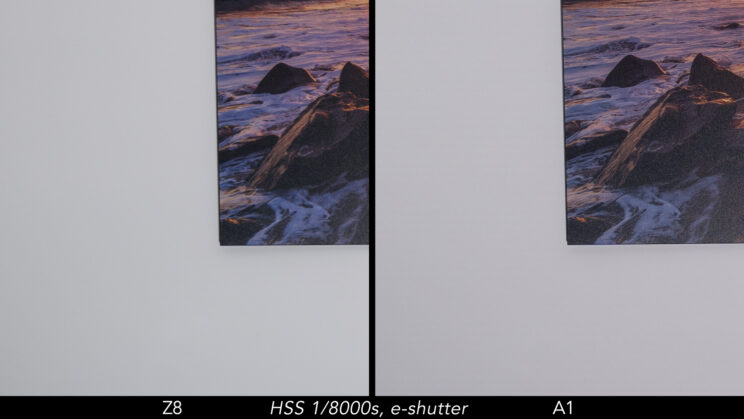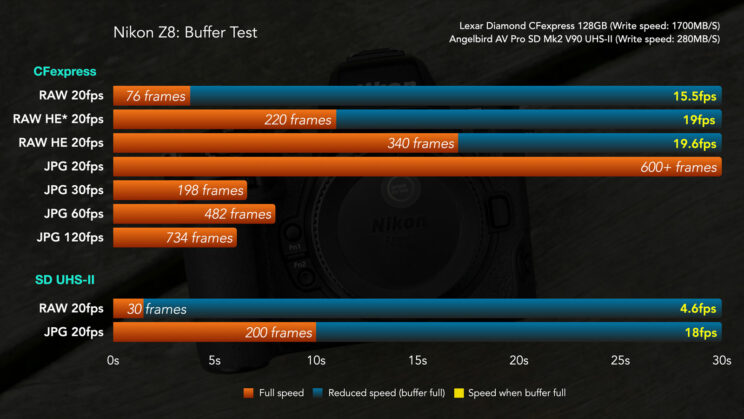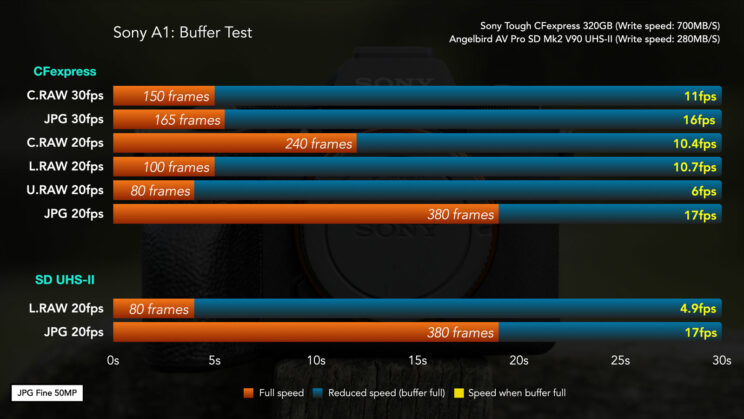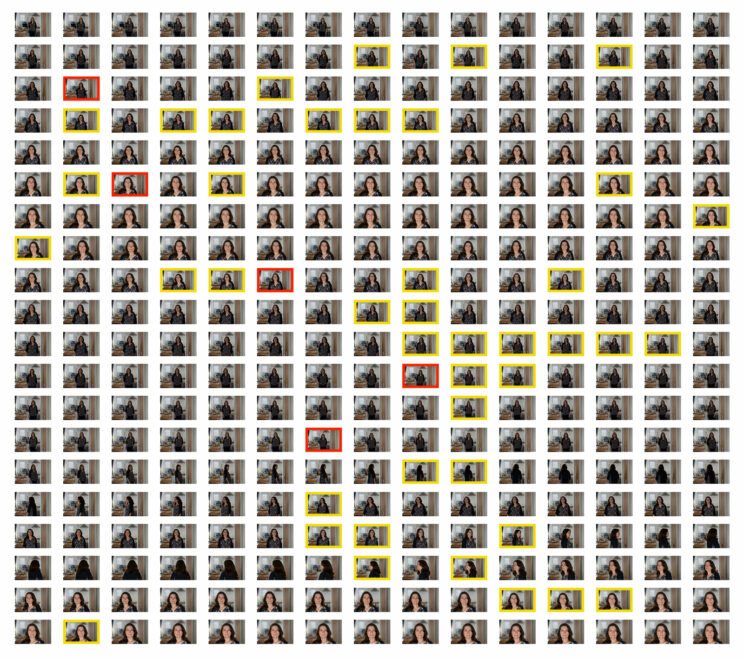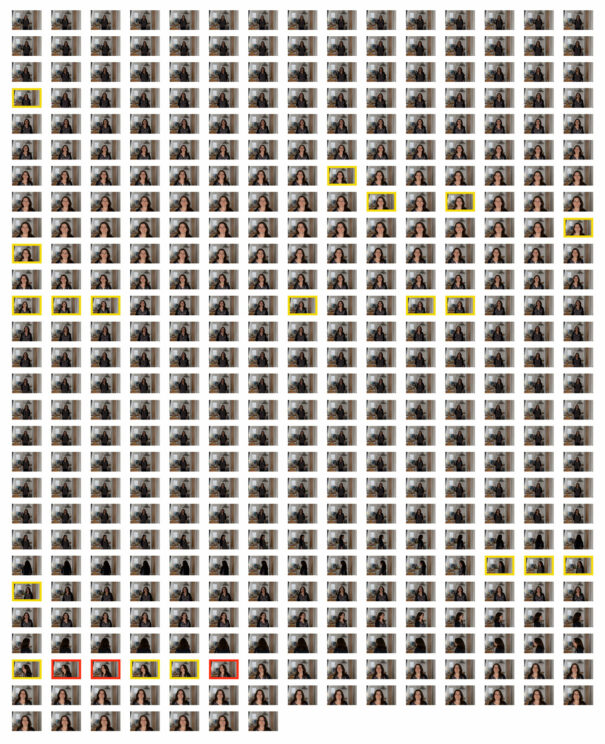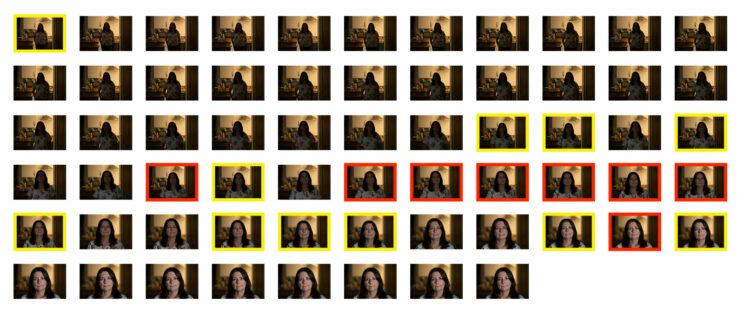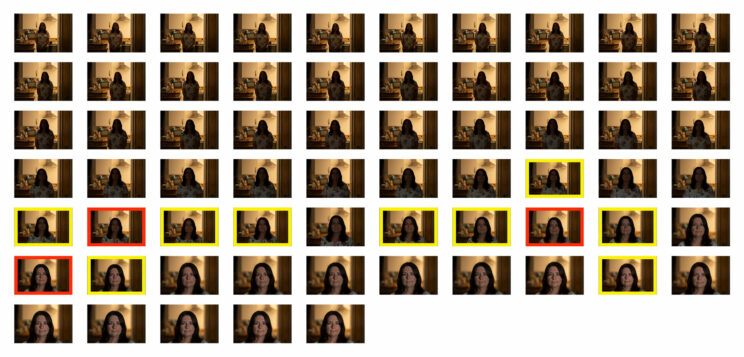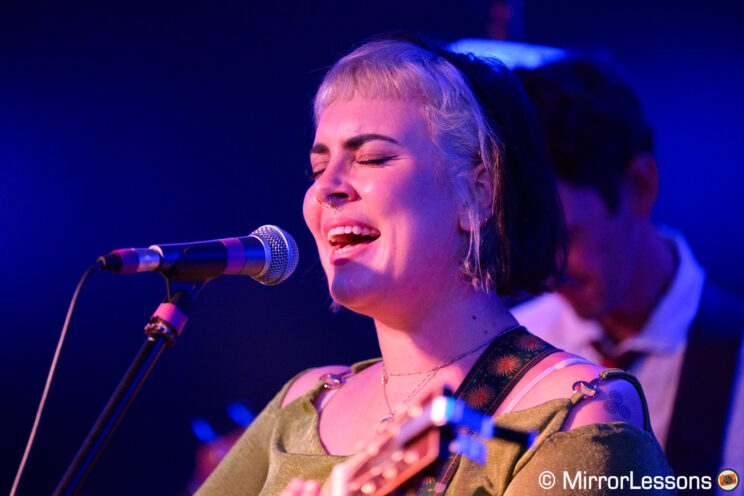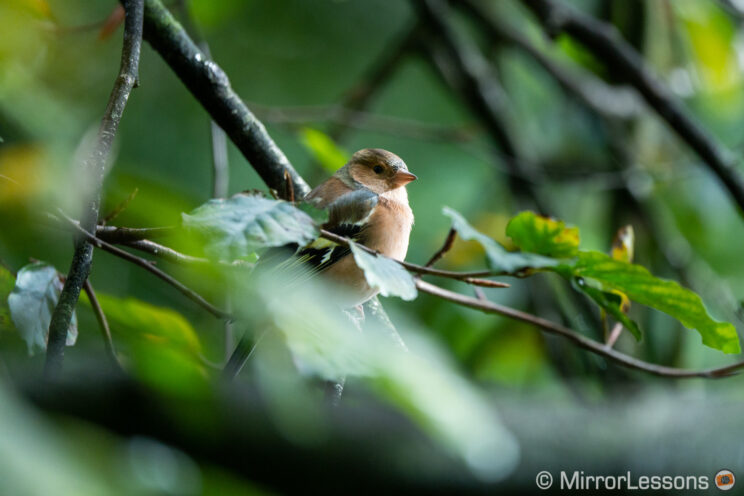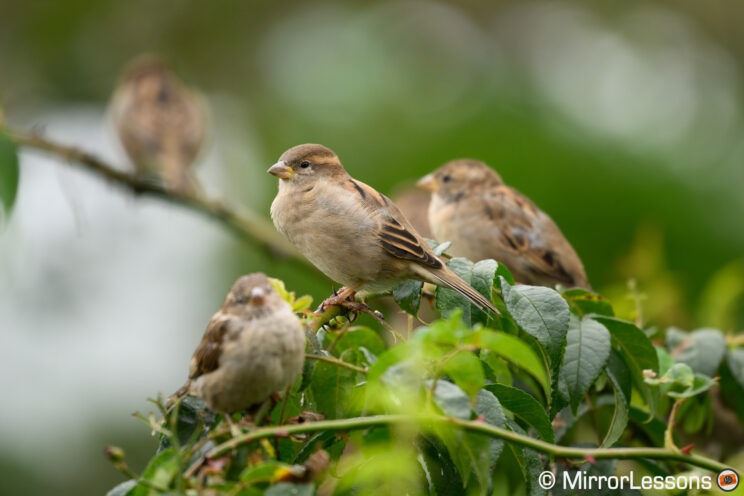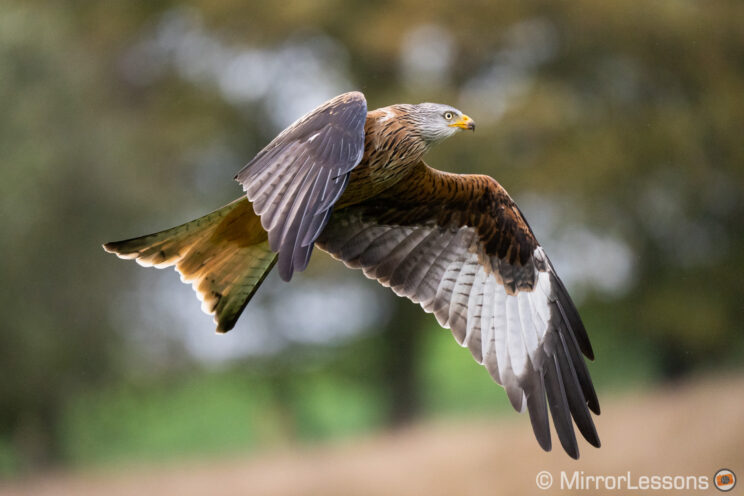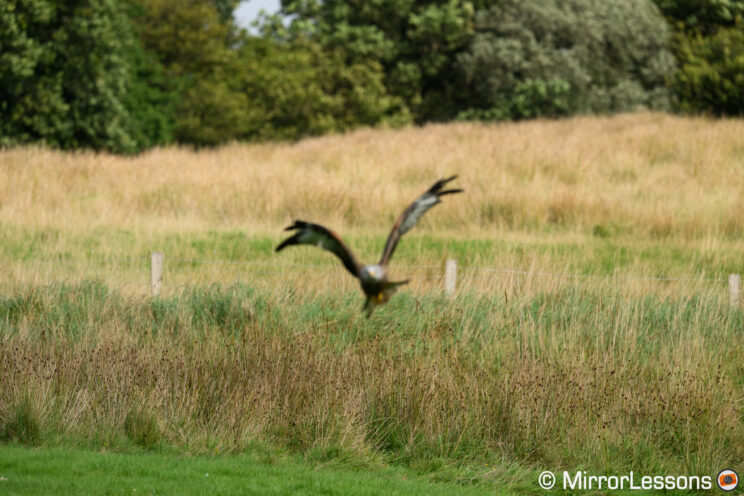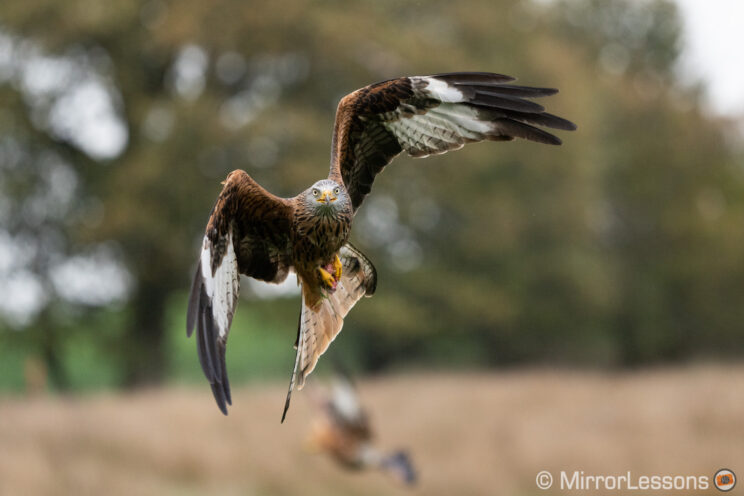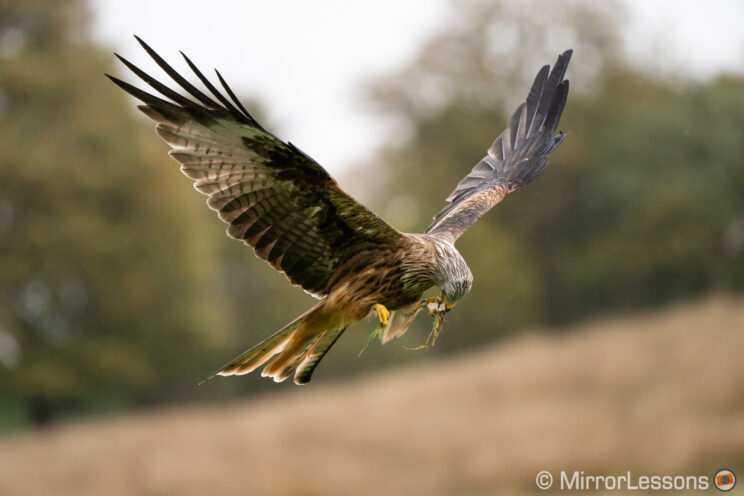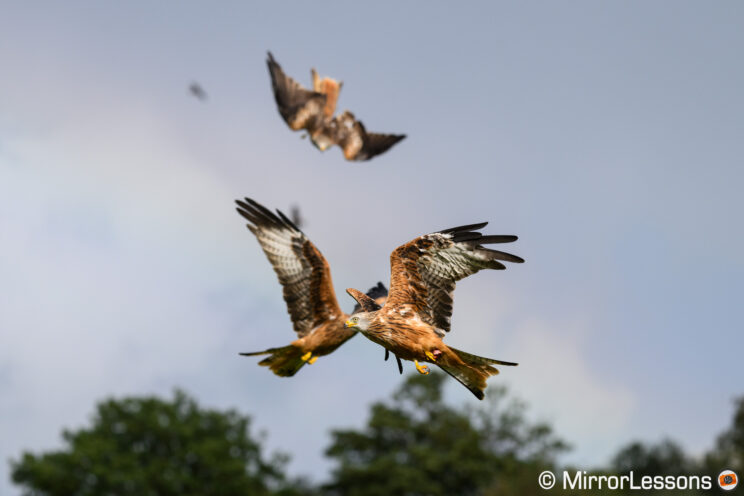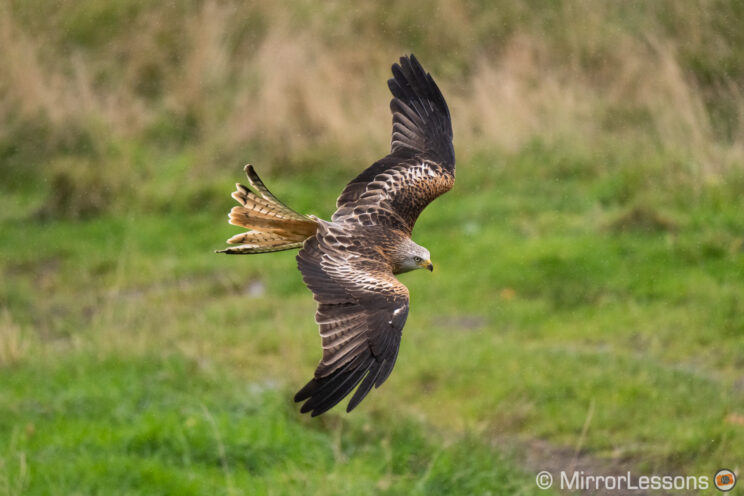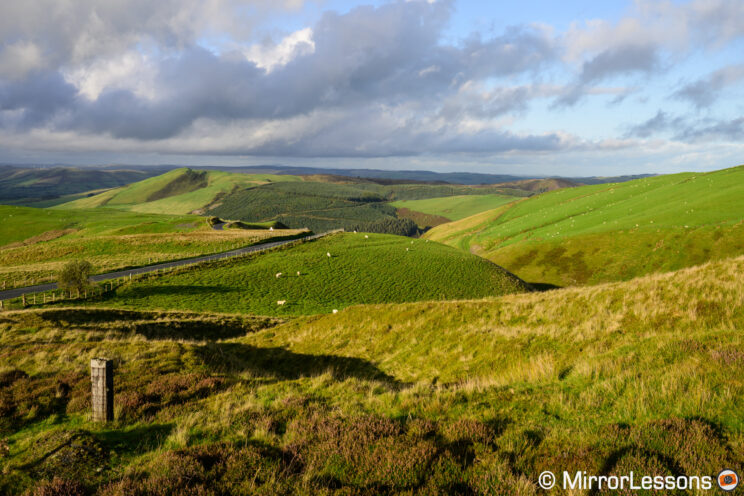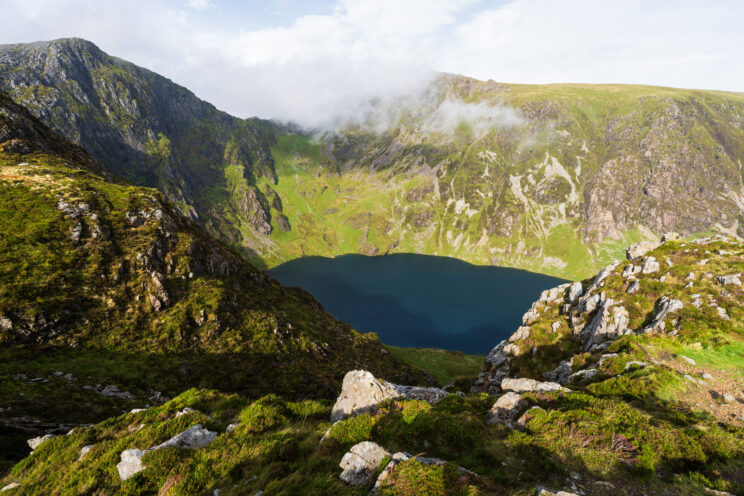You may wonder why I am comparing two cameras with such different prices. The Sony A1 is the company’s flagship model and not only it is substantially more expensive than the Z8, but it also costs more than Nikon’s top-of-the-line Z9.
However, if you momentarily set aside the price, you’ll quickly realize, by reading this article, that the A1 and Z8 share many similarities when it comes to technology, performance, and quality. Additionally, the Z8 is closer in size to the Sony than the Z9.
While the Nikon model may be categorized and priced to compete with the A7R IV and A7R V, the disparity in technology and speed is more substantial. This is why I find the A1 more compelling to compare. It represents the very best Sony has ever released, just as the Z8 exemplifies the best Nikon can offer to photographers (in case you’re curious, the Z8 and Z9 are identical on the inside).

Ethics statement: the following is based on our personal experience with the Nikon Z8 and Sony A1. We were not asked to write anything about this product, nor were we provided any compensation of any kind. Within the article, there are affiliate links. If you buy something after clicking one of these links, we will receive a small commission. To know more about our ethics, you can visit our full disclosure page. Thank you!
Table Of Content
1. Main Specs
2. Design
3. Connectors, Cards, Battery
4. Viewfinders and Monitors
5. Image Quality
6. Sensor Shift
7. Shutter
8. Continuous Shooting
9. Autofocus
10. Bird Photography
11. Video
12. Extra Features
13. Price and Lenses
14. Conclusion
Main Specs
Z8
- Sensor: 45.7MP Stacked CMOS
- Format: FX (35mm / full frame)
- Lens system: Z-mount
- Weather resistant: Yes
- Stabilisation: 5-axis and Synchro VR (6 stops)
- Autofocus: phase/contrast detection with 493 points, subject detection (humans, animals, vehicles, planes)
- Continuous shooting: 20 fps with RAW, 120 fps with JPG
- ISO Sensitivity: 64 – 25,600 ISO (32 – 102,400 extended)
- Shutter Speeds: 1/32,000s to 30s, Time, Bulb
- Viewfinder: 0.5-in OLED with 3.69M dots, 23mm eye point, 0.8x magnification, 120fps
- Rear monitor: 4-axes 3.2″ LCD (2.1M dots) with touch sensitivity
- Movie recording: 8K up to 60p, 4K up to 120p, 12-Bit RAW (internal), Prores 422 HQ, HLG and N-Log
- Built-in Flash: No
- Extra Features: WiFi, Bluetooth, Focus Bracketing, Pre-Release Capture, Tethering, Time-lapse, Dual card slots (CFexpress / SD)
- Dimensions: 144 x 118.5 x 83 mm
- Weight: 910g (including battery and memory card)
- Firmware version when tested: 1.01
- Release: 2023
A1
- Sensor: 50.1MP BSI Exmor RS CMOS
- Format: 35mm (full frame)
- Lens system: E-mount
- Weatherproof: Yes
- Internal Stabilisation: 5-axis (5.5 stops)
- Autofocus: 759 phase / 425 contrast detection points, Subject Detection (Humans, Animals, Birds)
- Continuous shooting: 30 fps
- ISO Sensitivity: 100 – 32000 ISO (pull 50, push up to 102400)
- Shutter Speeds: 1/32000 to 30s, Bulb
- Viewfinder: 0.64in OLED with 9.44M dots, 25mm eye point, 0.90x magnification and 240fps refresh rate
- Rear monitor: Tilting 3.0in LCD (1.44M dots) with touch sensitivity
- Movie recording: 8K up to 30p, 4K up to 120p, 10-bit 4:2:2 internal, S-Log3, S-Cinetone and HLG, 16-bit RAW via HDMI
- Built-in Flash: No
- Extra Features: WiFi, Bluetooth, Bracketing, Intervalometer, Tethering, Pixel-Shift Multi Shot, Hybrid CFexpress/SD dual slots
- Dimensions: 128.9 x 96.9 x 80.8 mm
- Weight: 737g (including battery and memory card)
- Firmware version: 1.32
- Release: 2021
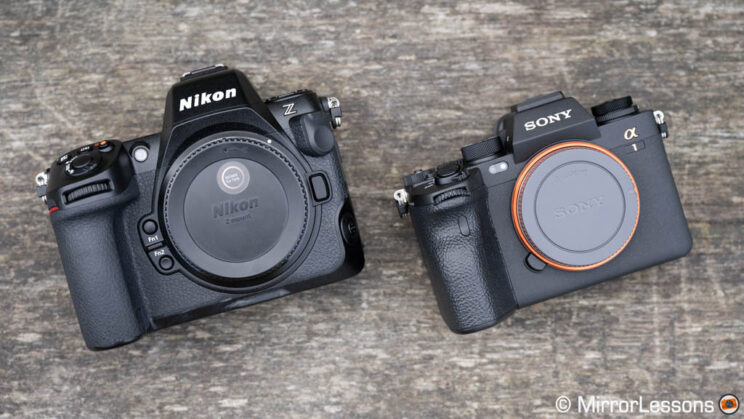
Design
The Z8 is notably larger than the A1, and you can feel the difference in weight. Both cameras offer weather resistance, and while I didn’t put either of them under stress for this comparison, right out of the box, the Nikon feels like the one with the stronger build quality. It reminded me of my old D700 DSLR, which was literally built like a tank.
- Z8: 144 × 118.5 × 83 mm, 910g
- A1: 128.9 x 96.9 x 80.8mm, 737g
About the Nikon Z8 Recalls
My experience with the camera was flawless but limited to a short 3-week rental. Early users have been less lucky and Nikon has issued two official recalls: one for an issue with the mount and one for a problem with the strap’s eyelets. You can find out more information on the Nikon website and see if your Z8 is affected or not.
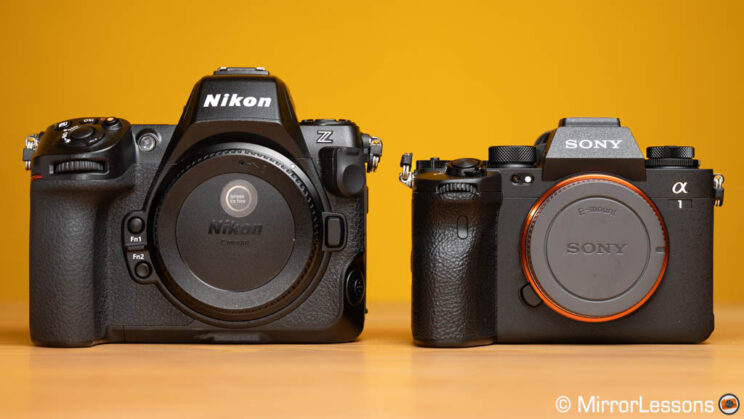
I’m not going to tell you which one is the better camera because design and size are also matters of personal preference. Pair the A1 with compact prime lenses, or even the latest pro zooms like the 16-35mm F2.8 GM II, and you have a relatively lightweight and compact combination that also happens to deliver some of the most terrific image quality you can find.
Recently, I hiked up a mountain here in Wales with this exact combo attached to the shoulder strap of my backpack (using Peak Design’s Capture Clip), and the weight never bothered me for a moment. The larger size of the Z8 could have been more uncomfortable with the same setup (obviously, this is just one niche example).
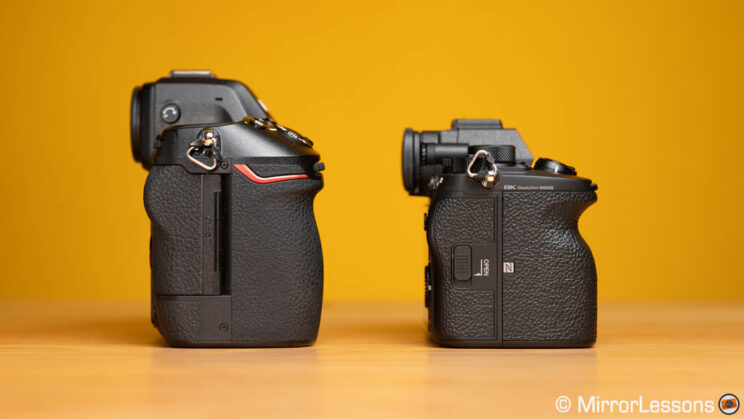
The compact design is tempting, but it also has its limits. The grip is smaller and more uncomfortable as soon as you start to use larger and heavier lenses like the FE 200-600mm. Switch to the Z8 with the equivalent Nikkor Z 180-600mm, and the difference is like night and day. The Nikon is much more comfortable; all your fingers find their place without the need to squeeze them, which also means the grip feels more secure and much less tiring after a long day of shooting.
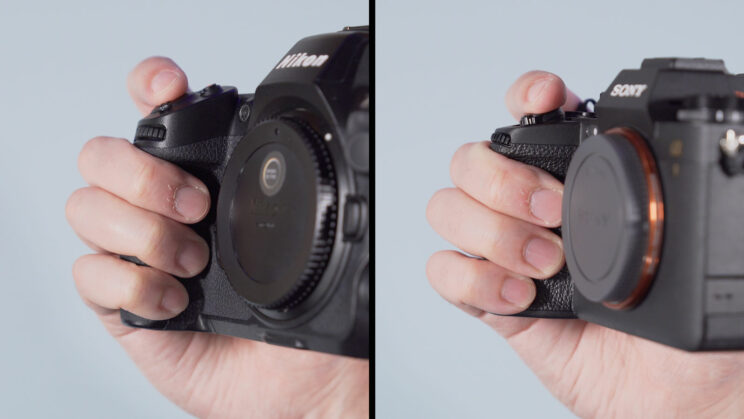
The Z8 is in a league of its own also when it comes to the overall ergonomics and controls. You get a handy top LCD screen to monitor your settings, extra buttons around the body (two in front near the mount, and the AF mode button on the side), and a handy photo/video switch. The cherry on top? Many of these buttons are back-illuminated!
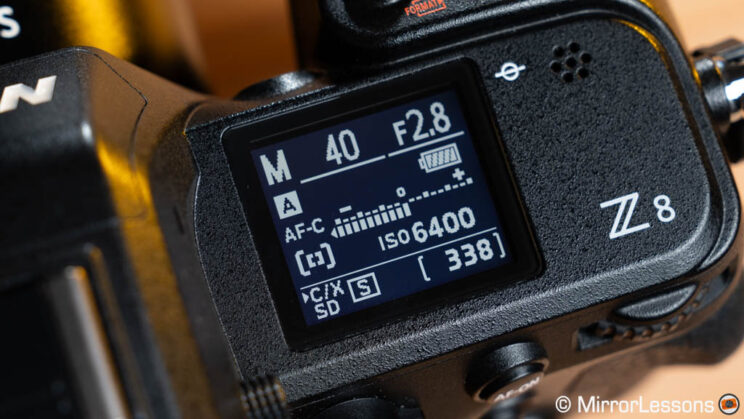
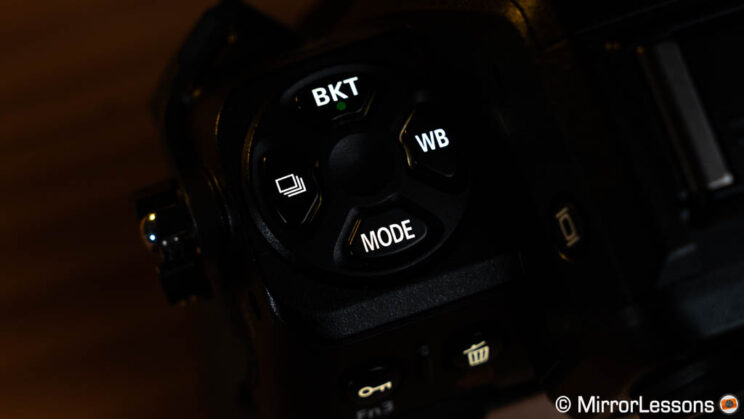

Using the A1 again, after three weeks with the Z8, feels like Sony still show some immaturity when it comes to professional camera design, although they have been in the game for a while now, so I also believe they like to do things differently and prioritise the small size (all Alpha cameras are very similar when it comes to dimensions).

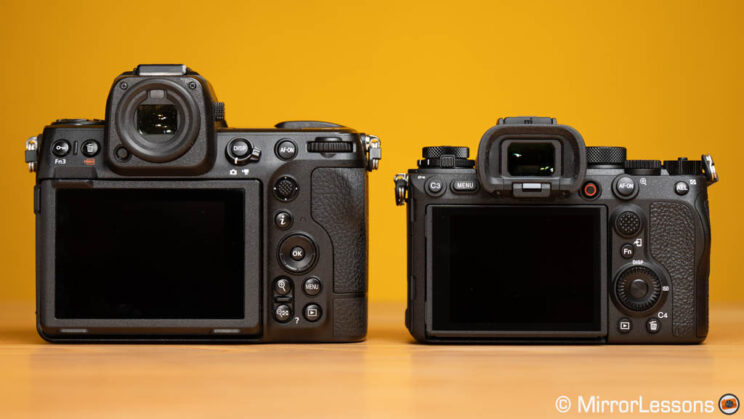
With that said, the A1 is far from terrible. It offers a good number of buttons and dials, including the stacked focus mode/drive dial (although the focus dial is a bit awkward). Most of the controls are responsive and precise, including the AF joystick at the rear.
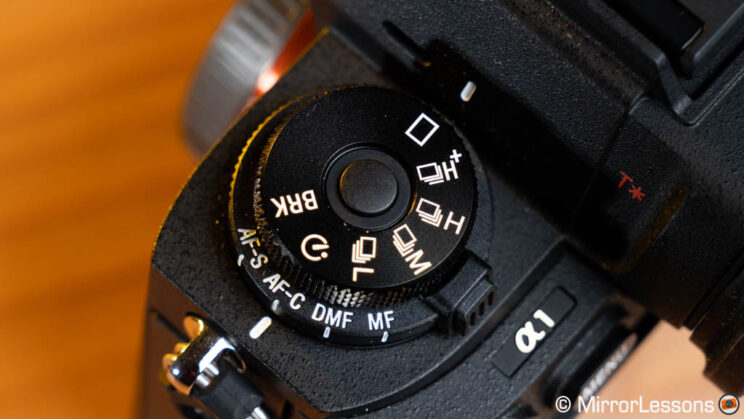
The Sony also offers a bit more in terms of customization: 12 function buttons versus 10 on the Z8. Both cameras have programmable My Menu and Quick Menu, and buttons can be mapped separately for photo, video, and playback modes. In addition, you have function buttons on select lenses, and Nikkor Z lenses come with a customisable ring that can control the aperture, ISO, or exposure compensation.
On the Z8, My Menu can be accessed via a function button, and you can choose to display the most recent settings used rather than a custom list.
The organization logic is also unique to each brand. For instance, the two menus have a completely different layout, and it might surprise you, but I prefer the Sony version: it’s easier to navigate, whereas Nikon tends to place half the options of certain settings in one place and the other half somewhere else (sounds familiar? That was Sony a few years ago!). Also, the list of settings you can assign to function buttons is the same for every key on the A1, unlike the Z8, where some buttons only get half the list for some reason.

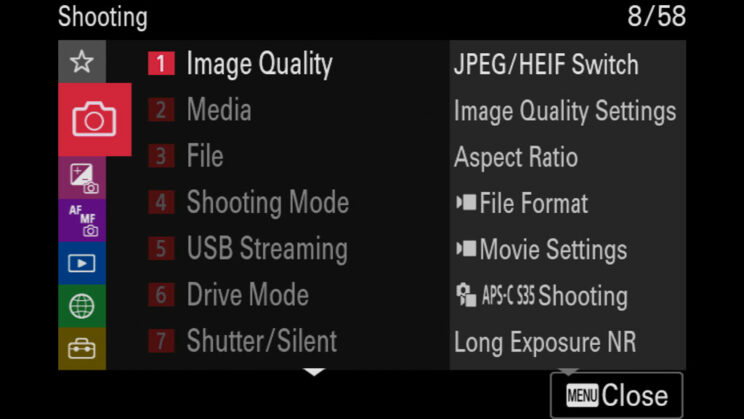
One thing I like on the Z8 is that many buttons work with press-and-hold by default, and you change values with the front and rear dials, something that becomes second nature once you get used to it. Note that you can choose to press and release instead, if you prefer that method.
The A1 features the standard shooting mode dial on top, with three Memory Recalls that allow you to load up to three combinations of settings you previously saved. For example, you can have your portrait settings on C1, your wildlife settings on C2, and so on.

The Z8 has a Mode button at the top, but if you want a similar solution to the Memory Recalls, you need to look at what Nikon calls “banks.” You’ll find three of them, and each allows you to save up to four different presets for the photo shooting menu, the video shooting menu, and the Custom Settings.

The main advantage of banks is their independence from any of the photo/video shooting modes (PSAM), and you don’t need to save them. They stay as you leave them when turning off the camera. You can also give them a custom name.
Connectors, Memory Cards and Battery Life
The Z8 and A1 come equipped with a 3.5mm microphone input, a 3.5mm headphone output, a full-size HDMI port, and a Type-C USB connection. The Nikon actually has two of the latter: a faster USB port for file transfer and a second one for power delivery. Similarly, the A1 sports a Micro USB port that can be used for certain accessories.
Additionally, the Z8 features a 10-pin remote terminal at the front, whereas the A1 has a flash sync socket and a LAN terminal.
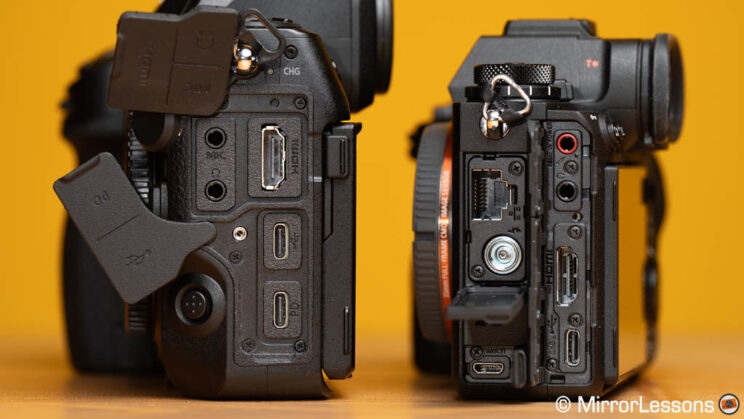
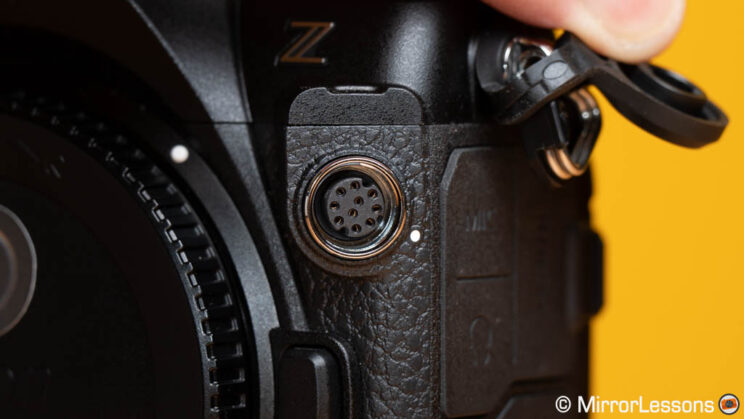
Next, let’s talk about memory cards: the Z8 has one slot for CFexpress Type B (or XQD) cards and one for SD UHS-II cards.
The A1 comes with an interesting solution: both slots are hybrid and accept either a CFexpress Type A card or an SD UHS-II card.
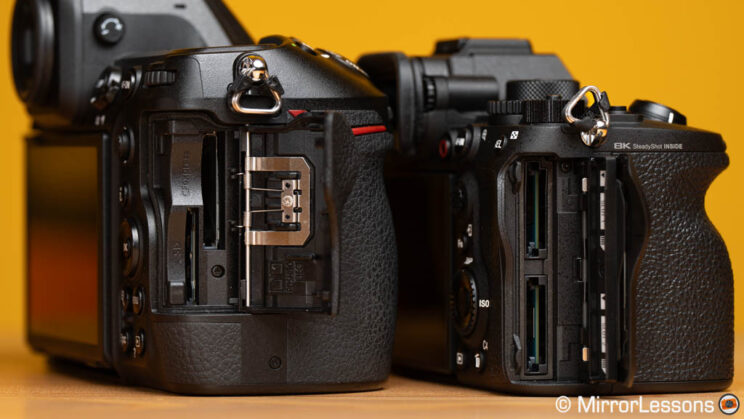
CFexpress cards offer faster writing and reading speeds. Faster writing means the cameras can clear the buffer more quickly and can record with more demanding video formats (N-RAW on the Z8, Slow Motion in 4K All-Intra for the A1, for example).
Note on N-RAW video: Out of the two CFexpress cards I had with me, only the Lexar Professional Diamond (1700MB/s) worked. With the SanDisk Extreme Pro (1200MB/s), the Z8 stopped after a few seconds.
The CFexpress Type B card is larger than the Type A card and offers faster speeds as well. At the time of writing, there is also a bit more choice with Type B cards because Sony is the only brand that has adopted the A format at the moment.
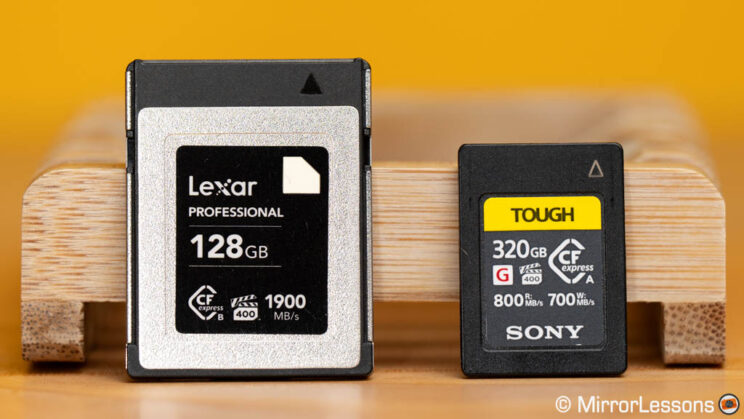
Regardless of these technicalities, the main advantage with the A1 is that you can use either two CFexpress or two SD cards. Additionally, this allows you to back up 8K video to the second card or record in relay when the first slot is full, something you can’t do on the Z8 for video (but you can for photos).
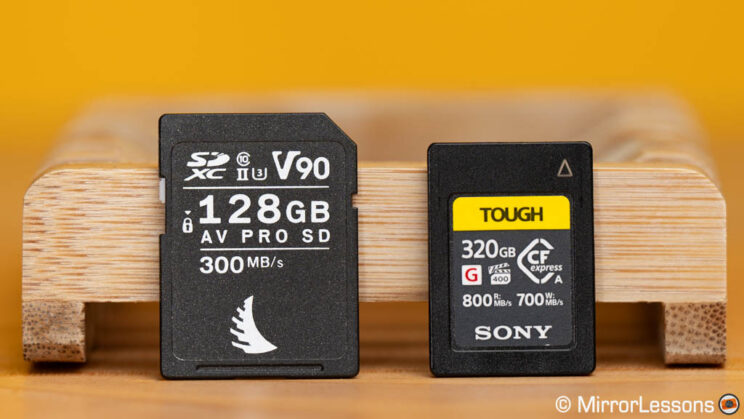
As for the battery, the official ratings are as follows (CIPA standards):
- Z8: 340 frames (LCD), 330 frames (EVF)
- A1: 530 shots (LCD), 430 shots (EVF)
What about real-life performance?
Well, two hours at the red kite feeding station with the Z8 allowed me to capture almost 6,000 images and various 8K 60p and 4K 120p clips. The battery showed 51% remaining when I left.
The A1 battery dropped to 48% a few days later, with 3,400 photos and multiple 8K 25p and 4K 120p clips as well. Kudos to both, but the Nikon is not inferior as the CIPA data suggests.
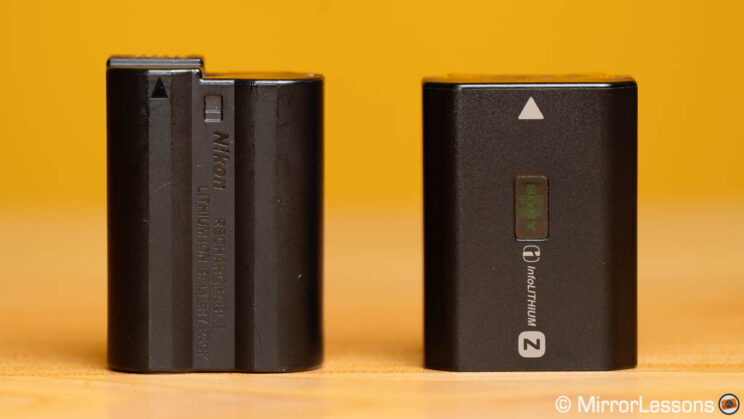
For video, the Z8 managed 110 minutes in 4K 25p and 105 minutes in 8K 25p before the battery died.
The A1 recorded 63 minutes of 8K 25p before overheating (more on this in the video chapter). There was 30% of battery life left, which could have possibily allowed for an extra 27 minutes or so (90 minutes in total). In 4K 25p, the Sony battery lasted for 114 minutes.
Viewfinder and Monitors
Nikon gave the Z8 the same viewfinder found on the flagship Z9. It boasts a 0.5-inch OLED panel with 3.69 million dots of resolution, a magnification of 0.80x, a 23mm eyepoint, and a maximum refresh rate of 120fps.

Sony, on the other hand, equipped the A1 with their best EVF to date: a 0.64-inch OLED panel with an astonishing 9.44 million dots of resolution, a larger magnification of 0.90x, a longer eyepoint (25mm), and a refresh rate that goes all the way up to 240fps.
On paper, the A1’s viewfinder is certainly the best. But is it perfect in every way? Well, that depends on how you look at it. The panel is large, and when you set the Display Quality to High, you can truly appreciate the resolution and fine details it offers. It’s gorgeous, and manual focusing is highly precise, to the point that you don’t need a manual focus aid very often.
However, you can’t have the full 9.44 million dots with the fastest refresh rate. At 120fps, the resolution drops (I’m not sure by how much, but it’s noticeable). Additionally, when engaging Continuous Autofocus (C-AF), the resolution decreases momentarily (even with the quality setting on High). Last but not least, at 240fps, the resolution not only worsens, but the magnification is also reduced to 0.70x.

Personally, these limitations are not a deal-breaker for me. A fast refresh rate is useful for capturing action shots where you won’t have the time to appreciate all the minute details that the maximum resolution can provide. A 0.70x magnification at 240fps means I can see the entire frame easily, including the four corners, when wearing glasses, so there’s a positive aspect to that.
The Z9’s specifications may not be as impressive for a camera in 2023, but they remain consistent: whether you set the faster frame rate or not, the resolution doesn’t change. Additionally, the panel is HDR compatible and can reproduce excellent brightness and tonal range when recording HEIF or HLG formats.
At the rear, the Z8 boasts a larger 3.2-inch LCD screen with higher resolution (2.1 million dots). Moreover, the monitor has a 4-axis articulation, allowing you to tilt it up when working in a vertical orientation – a very useful feature! I found it a bit tricky to lift the monitor at first (when it is fully retracted against the camera), but it’s a minor issue.
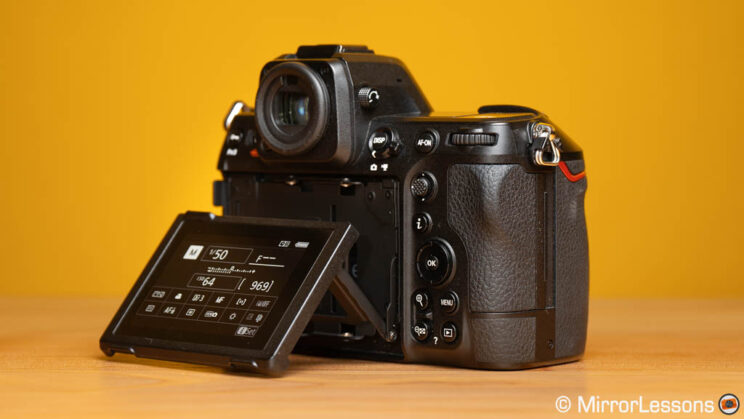
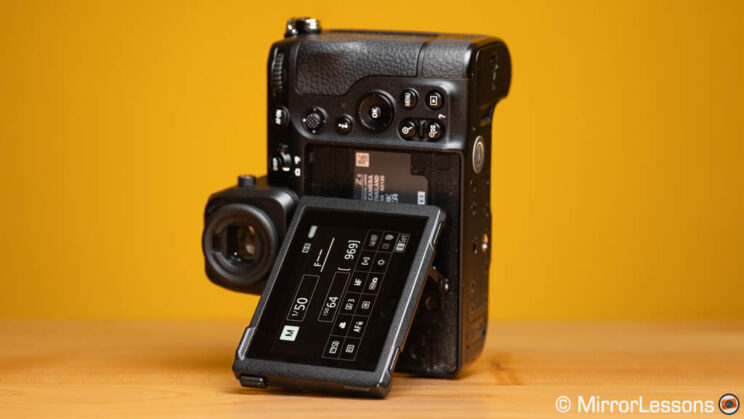
The A1, despite all its glorious tech and price, gets a tilting-only mechanism with a mediocre 3.0-inch LCD panel that has 1.44 million dots and produces subpar colors. This is not the screen you’d expect to see in a top-of-the-line flagship $6,000+ camera. At least, you can perform certain functions with touch gestures, like navigating the menu (same for the Z8).
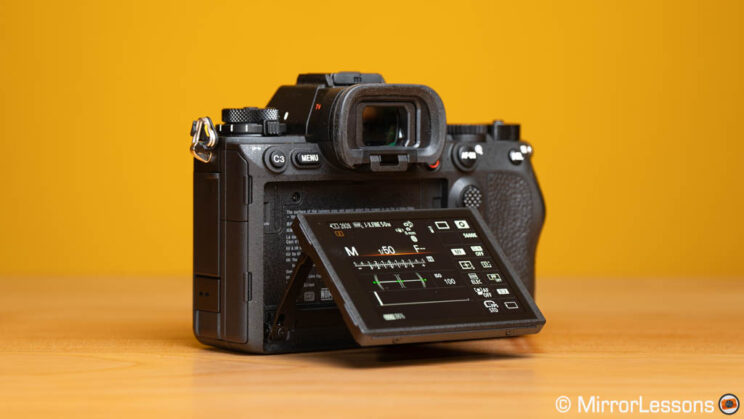
Image Quality
The Z8 and A1 come with full-frame sensors, but they have slightly different resolutions: 45.7MP for the Nikon and 50.1MP for the Sony. The technology is similar in the sense that both sensors have a stacked design to improve the readout speed, and the A1’s sensor also has a backside-illuminated architecture. Neither of them comes with a low-pass filter.

The quality of details will be influenced by the lens mounted in front, but here’s how sharpness looks with these two cameras and their respective pro standard zoom lenses. Needless to say, they both meet expectations. That said, for those who scrutinize images at extreme levels, we can notice a bit more moiré on the Z8.
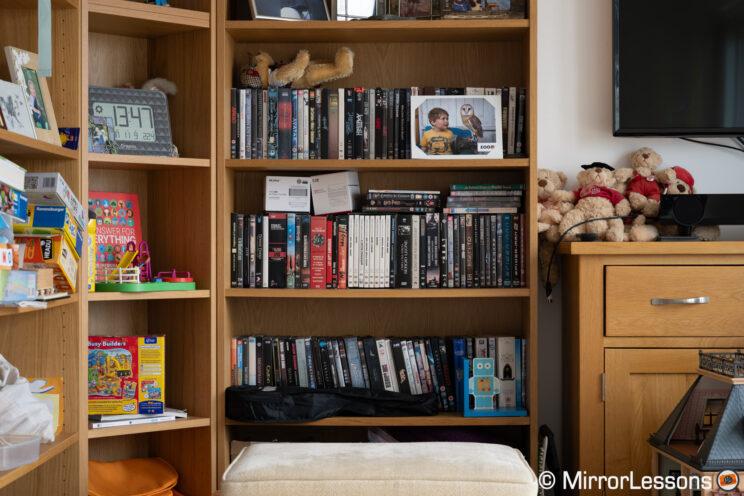
Sony FE 24-70mm F2.8 GM II
In terms of files, both cameras offer 14-bit RAW, 8-bit JPG, and 10-bit HEIF formats. The Z8 lets you choose between Lossless Compressed RAW and the two High Efficiency modes. The A1 offers Uncompressed, Lossless Compressed, and Compressed RAW options.
My dynamic range test shows very similar results when it comes to shadow recovery. With a 3-stop boost in post-processing, the RAW files remain clean and show little signs of noise.

A1: 1/13 sec, ƒ / 8.0, ISO 100
With a more severe adjustment of 4 stops, the A1 shows a bit more noise (especially in the blue coat), whereas the Z8 exhibits a slight color cast. Overall, the results still look very strong.
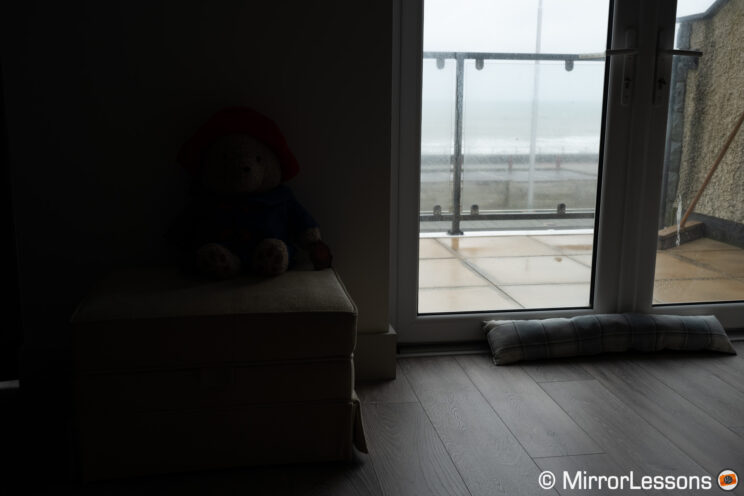
A1: 1/25 sec, ƒ / 8.0, ISO 100
If we push it to the extreme with a 5-stop recovery, noise becomes more noticeable, but hopefully you won’t need to do this very often!

A1: 1/50 sec, ƒ / 8.0, ISO 100
When it comes to highlights recovery capabilities, the A1 has a clear advantage and saves more information outside the window.
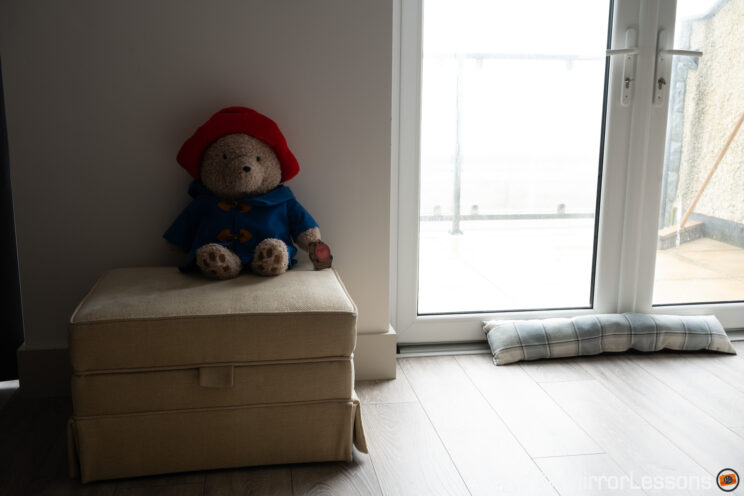
A1: 0.6 sec, ƒ / 8.0, ISO 100
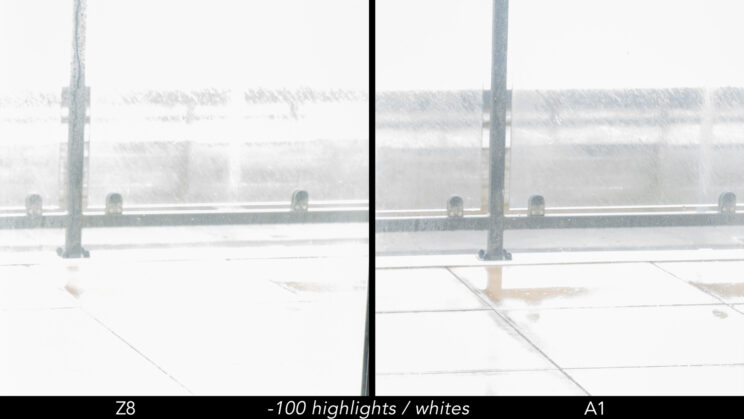
The ISO range is slightly different between the two cameras, with the Z8 starting with a lower base value.
Photos
Normal range
Extended range
Z8
64 – 25,600
32 – 102,400
A1
100 – 32,000
50 – 102,400
Here’s an interesting finding: with the same exposure settings, the Z8 image is half a stop brighter. I used the Nikkor Z 70-200mm F2.8 S and Sony FE 70-200mm F2.8 GM II, so we could attribute the difference to the light-gathering capabilities of these two lenses. However, the same exact test in video mode a few minutes later showed equal brightness between the two cameras.
I adjusted the shutter speed slightly to match the brightness as closely as possible so that we can compare similar images.
Both cameras perform well up to 1600 ISO, with very contained noise. The images look good up to 6400 ISO, after which noise becomes more pronounced. But up to 25,600 ISO, they’re not terrible if you really need that level of sensitivity. As expected, the high extended levels are less attractive.
Next, let’s examine colors with the straight-out-of-camera JPGs. Starting with a landscape image, the Z8 produces a warmer look overall but loses some of the blue tones on the water, making it the image a bit less realistic.
With the Vivid profile, they both produce a similar amount of contrast and green vibrance, but once again, the Z8 image is warmer while the A1 preserves more blue tones.
Moving on to a portrait example, the Sony image has a bit more red and magenta with the Standard profile.
With the Portrait profile, the Z8 has softer contrast and softer red tones.
With the Neutral profile, the A1 produces less saturation.
As always, remember that you can shoot RAW and have much more versatility in post-processing, or tweak settings in the camera like Saturation and WB Shift to adjust the colour rendering.
The Nikon has additional parameters tailored for portraits, such as Portrait Impression Balance, which allows you to create up to three presets with different hue and brightness adjustments. There is also Skin Softening, which smooths out people’s faces with three levels to choose from.
Sensor Shift Mechanism
Both cameras feature in-body stabilization thanks to the sensor shift mechanism, which moves on five axes (roll, pitch, yaw, x, and y) to compensate for camera shakes. They have similar ratings: 5 stops for the Z8 and 5.5 stops for the A1.
The rating on the Nikon can go up to 6 stops with Synchro VR, which improves performance with select VR lenses (optical stabilization). Unfortunately, there is little information available about Synchro VR, not even an official list of compatible lenses. I presume it can maintain that level of stabilisation even with longer focal lengths, but I couldn’t find a confirmation on this.
As usual, I conducted a test in which I took 10 photos at each shutter speed to assess how capable the two cameras are in correcting movements and how consistent their performance is.
Overall, the Z8 is more capable of producing sharp handheld images between 1 second and 1/8s. The keeper rate is higher, and the performance is more reliable. I used the Nikkor Z 24-70mm F2.8 S and the Sony FE 24-70mm F2.8 GM II, both set at 35mm.
Stabilisation Test (35mm)
Shutter Speed
Z8
A1
2s
0%
0%
1s
40%
20%
1/2s
60%
20%
1/4s
80%
40%
1/8s
90%
60%
1/15s
100%
90%
1/30s
100%
100%
For video, relying solely on sensor stabilization yields disappointing results when walking, as both cameras fail to compensate for all the shakes appropriately.
If you activate digital stabilization (Electronic VR on the Z8 and Active SteadyShot on the A1), the performance improves significantly, and the Sony delivers smoother results overall. The footage from the Nikon is partially ruined by a large amount of unpleasant motion blur.
With static shots, testing at 200mm, the Z8 is more stable than the A1. Adding electronic stabilisation improves the result on both, notably the Sony, but the Nikon footage remains a bit smoother overall. Here, the optical stabilisation of each lens plays a significant role.
Note that Electronic VR is not available in 8K, 4K 120p, or when recording N-RAW or ProRes RAW for the Z8. Active SteadyShot doesn’t work in 8K and with 100/120 fps on the A1.
The Sony offers a third option, which is to stabilize the footage in post using the Catalyst software that can read the gyro sensor data embedded in the files. It works very well but there is always a loss of sharpness after exporting the videos.
Additionally, the Sony A1 takes advantage of the sensor shift mechanism for another function: Pixel Shift Multi Shooting. The camera can capture 4 or 16 images in a row and move the sensor by 1 pixel or half a pixel between each frame. This means that every point in your scene is captured by at least one red, green, and blue pixel.
If you select the 4-image mode, only the color resolution increases (eliminating any moiré in the process) while the output remains at 50.1MP. If you choose the 16-image mode, also the image size increases to a whopping 200MP!
Like many functions of this kind, the camera needs to be mounted on a sturdy tripod to ensure the best results. Additionally, any movements within the scene should be avoided as much as possible. Sony provides an option to correct motion when merging the frames with the Imaging Edge software (it cannot be computed in-camera).
The challenge is that any type of motion, even branches gently moved by the wind in the background, can lead to a loss of sharpness or artifacts.
First, let’s have a look at what happens without motion correction: the water becomes flat, some of the branches and leaves lose all their details, and of course, a person walking results in a significant artifact.
If you enable the motion correction option, the people in the background look fine now. However, the quality of the details seems to lack a bit. Even with an extreme crop and a comparison to the single 50.1MP shot, certain areas like green leaves and small branches (the ones likely moved by the wind) have more clarity and look more natural in the single frame, despite the lower resolution. In short, it’s better to avoid anything that moves, which can limit the number of applications for this function.
Shutter
This is a fascinating chapter because both cameras have pushed the boundaries of what a sensor can do in terms of speed and performance, not just image quality.
Firstly, it’s important to note that the Nikon Z8 is ‘shutterless,’ which means it doesn’t have mechanical curtains that open and close when taking pictures. The camera exclusively uses the electronic shutter, just like the flagship Z9.
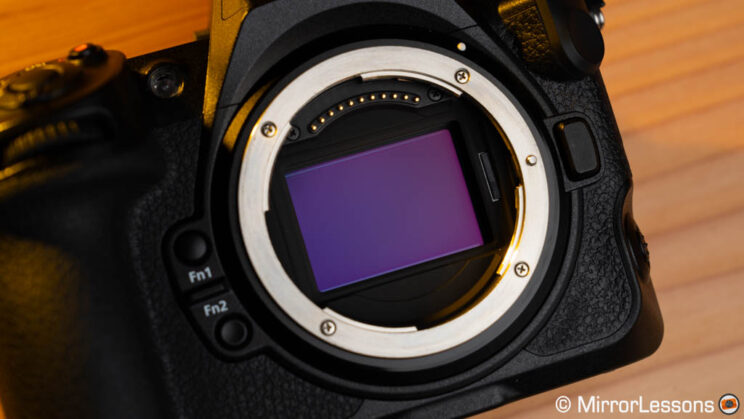
The only mechanical curtain inside the Nikon is a sensor shield, which comes down when you turn off the camera to protect the sensor when changing lenses. It is thicker than the standard mechanical curtains.
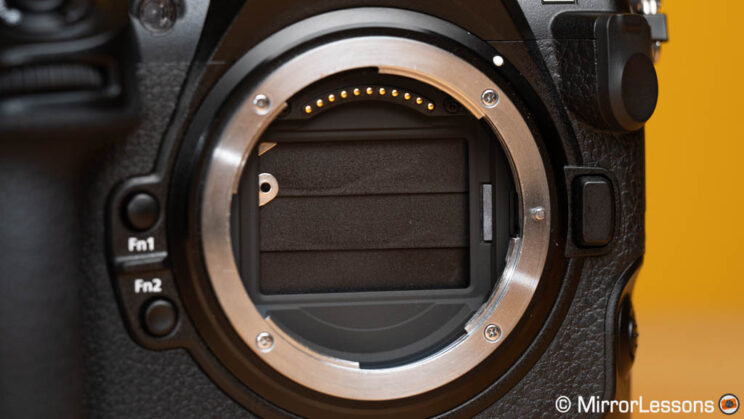
The A1 is on the same level when it comes to sensor technology, but Sony has chosen to keep a mechanical shutter. However, there is a clarification to make here: despite the camera’s menu, manual, and Sony’s website mentioning the words ‘mechanical shutter,’ the A1 actually has an electronic-first curtain shutter (EFCS) and not the full mechanical version. In short, there is only one physical curtain, and the other is activated electronically.
EFCS is generally useful to avoid shutter shock at select shutter speeds, especially with high-resolution sensors. However, they can introduce limitations, such as distorted bokeh with fast apertures and fast shutter speeds, or banding with artificial lights (usually very mild) or when working with flash in HSS mode.
The good news is that, in most cases, you can work with the electronic shutter on the A1 and avoid most of these problems. Thanks to the stacked design, the sensor readout is fast enough to be used in mixed artificial light situations without issues. I’ve taken the camera to several events and music gigs and have never encountered a problem. The same can be said for the Z8, which performed admirably at a recent music event.
Both cameras are so fast that even panning quickly with the electronic shutter results in very contained distortion (rolling shutter effect).
The electronic shutter also allows the Z8 and A1 to work at impressive continuous shooting speeds (more on this on the next chapter) and go all the way up to 1/32,000s with the shutter speed.
Last but not least, both cameras are capable of working with live view and no blackouts. This means they can manage two sensor readouts simultaneously: one that goes to the viewfinder or monitor (live view), and the other that is used to process and record the images. Whether you’re working in single or continuous shooting mode, there is no lag, no blackouts, nothing that interrupts or delays the view in the EVF or LCD. Interestingly, both cameras have options to enable a fake shutter sound or add blinking lines at the sides of the screen to indicate that you’re taking pictures!
So, the electronic shutter is perfectly safe in most situations. However, I did find a limitation with the A1: High-Speed Sync (HSS) with flash. I tested both cameras with my Profoto A10, and the Nikon was able to handle the fastest speed available (1/8,000s) without any issue. The A1, on the other hand, exhibited a bit of banding with the same settings, and switching to EFCS made things worse. This is where a full mechanical shutter would have had more sense on the Sony.

Banding on the A1 may not be very visible above, but you can see it better if I increase the contrast on the RAW file.
Unfortunately, the Electronic-First Curtain Shutter doesn’t help the A1 here.
This finding reveals that the Z8 has a faster sensor readout, with DPreview rating it at 1/270s compared to 1/260s for the A1. I know, it’s a minuscule difference, but it can still be relevant in very specific situations.
Note: without HSS, both cameras can sync speedlights up to 1/250s (Nikon) and 1/200s (Sony). The A1 can also go up to 1/400s (full frame) and 1/500s (APS-C) with the EFCS, so the latter does provide some benefits.
There are other potential limitations when using the electronic shutter, such as certain LED lights or electronic billboards that can test the limit of these cameras’ sensor readout. While I couldn’t delve further into this myself and couldn’t find relevant examples online, it’s safe to say that you’ll be fine 99% of the time. However, in that rare 1% of cases where something might happen, the faster readout of the Z8 might mitigate the problem more effectively than the A1.
Drive Speed
We’ve already touched on speed numerous times in this article, but how fast can these two cameras capture pictures in a row?
Well, both the Z8 and A1 perform exceptionally in this regard. The Nikon boasts an impressive capability up to 120fps, although it comes with certain limitations related to image file format, resolution, and sensor area. Here’s a breakdown of what the Nikon can achieve:
- 20fps (RAW, Full Frame, 45MP)
- 30fps (JPG, Full Frame, 45MP)
- 60fps (JPG, APS-C, 19MP)
- 120fps (JPG, Full Frame, 11MP)
In comparison, the A1 is no slouch either, offering 30fps with Compressed RAW or 20fps with any RAW compression. Both cameras support full autofocus and exposure tracking at all the mentioned drive speeds.
At 30fps, the A1 gains an advantage as it allows the use of RAW files. However, the Sony does not exceed this speed, while the Z8’s mind-blowing 120fps can be of great use for specific cases where speed is paramount, even if it sacrifices resolution.
An exclusive feature you’ll find only on the Z8 is the Pre-Release Capture mode, which lets you preload frames in the camera’s buffer memory before fully pressing the shutter release button.
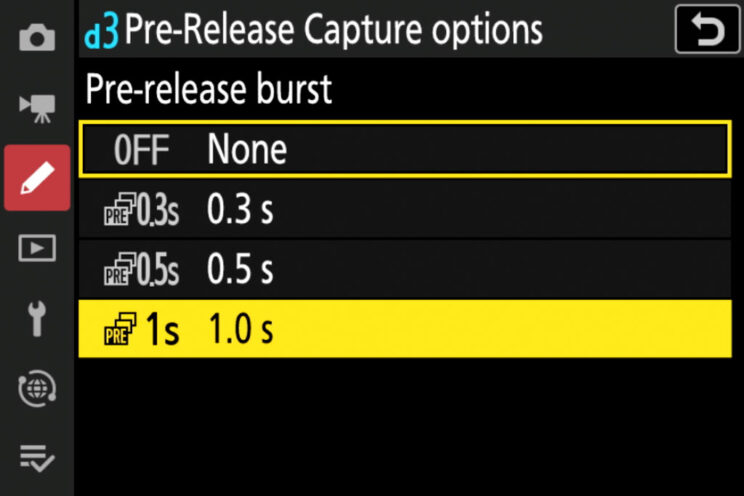
This is particularly useful when waiting for actions or movements that are challenging to anticipate. It works with all the previously described speeds, and you can also specify the number of frames before and after the button is fully pressed.
Notably, the A1 lacks such a feature, and it’s an area where Sony has yet to catch up, as they are the only brand not to offer this functionality at this stage.
While these drive speeds are impressive, their duration matters too. Let’s dive into the buffer memory. For both cameras, you’ll be able to shoot at the maximum speed for longer when using a CFexpress card, as these cards have faster writing capabilities, aiding the cameras in clearing the buffer more swiftly.
The Z8 can maintain 20fps for nearly four seconds when using Lossless Compressed RAW files. The performance further improves when selecting High Efficiency RAW. When shooting in JPG at 20fps, the camera doesn’t slow down. At 30fps and higher, the buffer is quite good, but the Z8 eventually stops entirely instead of continuing at a slower pace.
In contrast, the A1 can last for 5 seconds at 30fps and an impressive 12 seconds at 20fps when using Compressed RAW. Naturally, the performance diminishes when selecting Lossless or Uncompressed RAW. With JPGs, the camera can keep going at 20fps for 19 seconds before slowing down slightly (around 17fps).
Autofocus
Both cameras are equipped with a hybrid autofocus system that can perform a blazing 120 calculations per second. The Z8 boasts a maximum of 493 phase and contrast detection points (which drops to 405 points in Auto-area mode), while the A1 offers 759 phase and 425 contrast detection points.
These advanced autofocus systems come with subject detection algorithms that can identify people, animals, and birds. However, the Z8 extends its capabilities by recognizing various vehicles, trains, and airplanes.
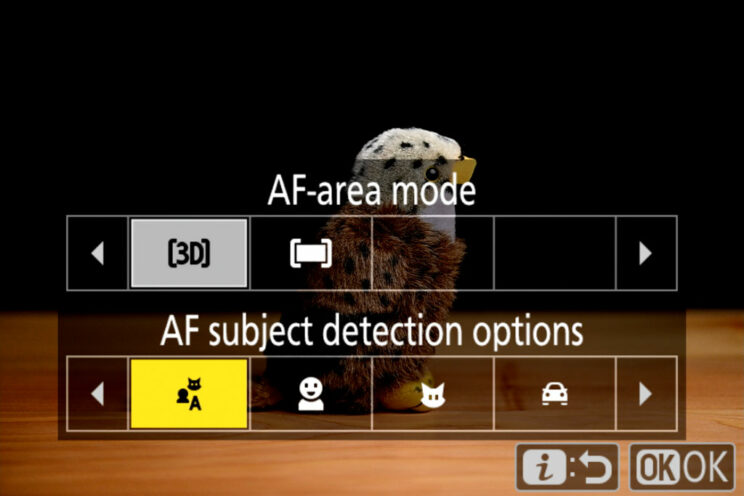
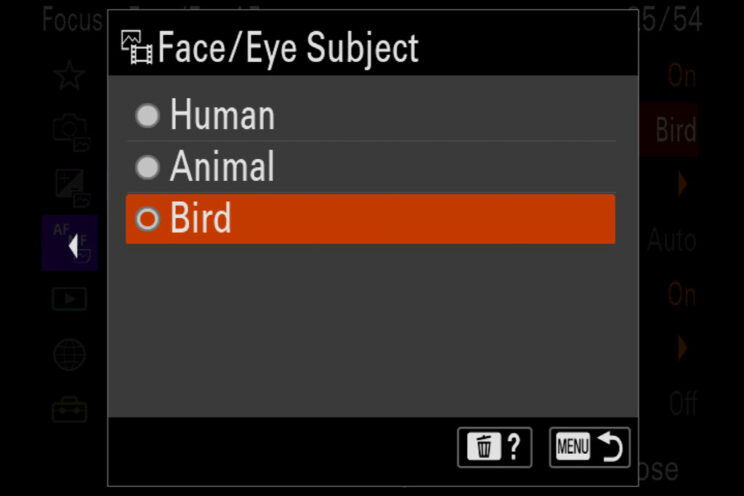
A distinction to note is that the A1 is limited to detecting the eyes of animals and birds. If their eyes aren’t visible, the camera will revert to the standard tracking mode (which is very accurate), whereas the Z8 will prioritize the head first.
In my first test, I assessed how well both cameras could maintain focus on a person’s eyes while they moved back and forth and rotated, making their face and eyes temporarily hidden. Typically, I choose a low drive speed for this type of test to avoid dealing with too many photos. However, given the rapid drive speeds of these two cameras, I deemed it fair to set them both at 20fps.
The Nikon Z8 achieved a good keeper rate of 84%. Notably, both the 3D Tracking and Wide-area settings produced the same results (combined with People Subject Detection). What stood out with the Z8 was its rapid focus acquisition on the subject’s eyes when the face became visible again. However, it did struggle somewhat in maintaining focus on the eyes throughout the entire sequence, leading to slightly soft images, thus explaining the less than perfect keeper rate.
In contrast, the A1 outperformed the Z8, delivering a nearly flawless hit rate of 95%. Most of the images marked as slightly soft (yellow) were challenging to evaluate because the focus imprecision was so minor. The A1 exhibited impeccable eye tracking, with minimal instances of misfocusing on eyelashes or the nose, which occurred more frequently with the Nikon.
The only time the Sony didn’t match the Nikon performance was when the subject rotated on herself, where the A1 was occasionally slower to react and acquire sharp focus on the eyes when they became visible again.
You may have noticed a disparity in the number of images captured by each camera: 300 photos for the Z8 and 412 for the A1. The walk lasted approximately 22 seconds. Multiplying that by 20 frames per second yields 440 frames, close to the Sony’s number. Why the Nikon number is so lower?
This discrepancy arises from the fact that I set both cameras to Focus Priority for the Continuous Autofocus (C-AF) mode. This means that they are supposed to release the shutter only when the subject is in focus, at least theoratically. The Z8 struggled more to maintain the person in focus consistently throughout, leading to the camera slowing down the drive speed, whereas the A1 was able to keep up at full speed from beginning to end.
The second test took place in challenging low light conditions. It was a shorter walk, where the subject moved from the shadows into near darkness before emerging into the light at the end. For this test, I used a drive speed of 10fps on both cameras.
On paper, the Z8 should have an advantage due to its superior low-light sensitivity:
- Z8: -7 stops (-9 with the starlight view mode), measured at f/1.2 and ISO 100
- A1: -4 stops, measured at f/2 and ISO 100, which would be equivalent to -5.5 stops with an f/1.2 lens.
The Starlight View mode on the Z8 is designed to enhance the brightness of the live view on your LCD or EVF, when working in very dark conditions. It can be used on S-AF and C-AF modes, although in this specific test, it didn’t make a significant difference.
The Nikon delivered a keeper rate of 79%, which is comparable to the previous result. However, with Focus Priority, the Z8 captured fewer frames because it stopped shooting when it lost the subject completely, resuming only at the very end. With Release Priority, or the Focus/Release Priority setting, the Z8 recorded more photos but had a lower keeper rate of 70%.
The A1 did better, achieving an 82% keeper rate and managing to capture more shots with Focus Priority enabled, further demonstrating its ability to keep up with movements and speed.
Although these tests serve the purpose of pushing the boundaries of each camera’s capabilities, they might not always align with the real-world conditions everyone encounters. Therefore, let me share some additional feedback.
One genre I’ve frequently ventured into is low-light events, particularly parties and music gigs. These situations present a unique set of challenges, including musicians’ rapid movements on stage or the lighting design changing often.
In this context, the Z8 performed really well, delivering a keeper rate of 90%. What particularly impressed me was how the AF area stayed locked onto the subject using 3D Tracking with People detection. Whether I zoomed in or out or reframed the shot, whether the person’s face was large or small on the screen, the AF consistently held onto the subject. The performance was very consistent, with only occasional minor issues with focus precision, preventing it from being perfect.
The A1, in these low-light scenarios, performed equally well as previously seen. It’s fast and consistent, with superior precision in tracking the subject. Having worked with the Sony at multiple events, I can attest that the number of slightly soft shots is close to zero.
Bird Photography
Since many of you follow my bird photography work, I thought I would dedicate a separate chapter to this genre.
First of all, the Z8’s bird detection capabilities are included in the Animal setting, while the A1 has a dedicated Bird option. It’s worth noting that Nikon recently released a new firmware for the Z9 that separates Birds from Animals, improving tracking performance in the process. It’s possible the Z8 will receive the same treatment at some point.
The Nikon works exceptionally well with birds perched on trees or other natural elements. The detection is instantaneous, and focusing on the eye is consistently fast and precise.
The A1 is equally impressive. You can use different methods to focus on the animal, with two different back-button focus solutions (the standard AF-ON and the specific Eye AF ON, where the eye is prioritized regardless of the focus area used).
Both cameras handle partial obstacles exceptionally well. A branch or leaf covering part of the bird’s body won’t prevent them from finding the eye to focus on, as long as the head remains clearly visible of course.
One advantage the Z8 has is when there are multiple subjects in your frame. The Auto-area mode gives you the possibility to switch between subjects using the AF joystick, allowing you to quickly tell the camera which one to prioritise. There is no such convenient option with the A1; you have to manually move the AF area over or near the bird you want to focus on.
Another advantage of the Nikon camera is that Animal and Bird Detection works for video as well, unlike with the A1, where Eye AF only works for humans. Furthermore, the standard tracking function on the Sony can only be activated using the touch screen. It would be far more convenient to assign it to a custom button.
Next, we have my birds in flight test, which I conducted at the red kite feeding stations, where I tested various combinations of settings to find the optimal setup. You can read more about it in my Best Mirrorless Cameras for Birds in Flight article.
The Z8 achieved its best autofocus score at 96%, the same score I got with the Z9 and only two points less than the A1, which remains the best camera I’ve tested for this specific scenario.
A1
98%
100%
Z9 / Z8
96%
100%
A9 / A9 II
96%
99%
R3
94%
100%
R5
90%
99%
A7R V
84%
97%
Note: The green score indicates perfectly sharp images only, while the blue score also includes slightly soft results.
A difference of 2% is practically negligible in a test like this, meaning that the two cameras perform at the same level. However, while analyzing the thousands of images I captured, a few more important observations emerged.
The first is about the drive speed. The Z8 achieved the best score at 120 fps, which is fantastic, but it also showed inconsistency in performance depending on the setting used, as shown in the table below.
Z8, 120 fps
96%
100%
Z8, 60 fps
93%
99%
Z8, 30 fps
83%
98%
Z8, 20 fps
90%
99%
The main reason for the Z8’s struggle is that it sometimes focuses on the background rather than the bird, especially when there are trees or other complex natural elements behind. This is more likely to happen at the beginning of the sequence when the camera needs to lock onto the subject and sometimes prefers what is behind it. This occurs more often when the kite is farther away, making it smaller in the frame.
The tip here is to wait a few seconds to ensure the camera shows a gray rectangle over the bird, confirming it has detected the subject before engaging the AF. If the camera still misfocuses, stopping and pressing the button again “forces” the Z8 to correct the focus more quickly. However, this also means that if you suddenly see something and don’t have the luxury of waiting a few seconds, the camera may occasionally fail you. To be fair, this doesn’t happen all the time, as I have many perfect sequences, but it’s something to keep in mind.
As for the A1, it works without any fuss whatsoever. The AF is fast, precise, and never misfocuses on the background. The performance is consistent, regardless of the drive speed you select. The best score I achieved was when working at 20fps, but a 4% difference with the score at 30fps is not a big deal, considering you save more photos per second.
A1, 30 fps
94%
99%
A1, 20 fps
98%
100%
I’ll conclude this chapter with the settings that gave me the best results on both cameras. Let me know if they work for you!
Z8
- AF-Area Mode: 3D Tracking or Custom Wide area
- AF Subject Detection: Animal
- AF-C Priority Selection: Focus
- Focus Tracking With Lock-On: 3 or 5, Erratic
A1
- Focus Area: Tracking with Expand Flexible Spot or Zone
- Face/Eye Priority in AF: On (not essential)
- Face/Eye Subject: Bird
- Priority Setting in AF-C: Focus
- AF Track Sensitivity: 5 (Responsive)
- Aperture Drive in AF: Standard
Video
The Z8 and A1 are both capable of 8K and 4K video recording, offering different formats and codecs to choose from. Let’s begin with a table summarising the many specifications.
Z8
A1
8K 60p
N-RAW
–
8K 30p
N-RAW
H.265 LongGOP
H.265 LongGOP
4K 120p
N-RAW
H.265 LongGOP
1.13x crop
H.265 LongGOP
H.264 LongGOP
4K 60p
N-RAW
Prores RAW
Prores 422 HQ
H.265 LongGOP
H.265 LongGOP
H.264 LongGOP
H.264 All-Intra
4K 30p
N-RAW
Prores RAW
Prores 422 HQ
H.265 LongGOP
H.264 LongGOP
H.265 LongGOP
H.264 LongGOP
H.264 All-Intra
Full HD 120p
Prores 422 HQ
H.265 LongGOP
H.265 LongGOP
H.264 LongGOP
Full HD 60p
Prores 422 HQ
H.265 LongGOP
H.264 LongGOP
H.265 LongGOP
H.264 LongGOP
H.264 All-Intra
Full HD 30p
H.265 LongGOP
H.264 LongGOP
H.265 LongGOP
H.264 LongGOP
H.264 All-Intra
Bit Depth/YCbCr
12-bit Bayer (RAW)
10-bit 4:2:2 (Prores)
10-bit 4:2:0 (H.265)
8-bit 4:2:0 (H.264)
10-bit 4:2:2 (both)
10-bit 4:2:0 (H.265)
8-bit 4:2:0 (H.264)
Max. Bit Rate (Mbps)
5780 (8K60p N-RAW)
1680 (4K Prores RAW)
220 (4K Prores HQ)
400 (8K 30p H.265)
400 (4K 120p H.265)
520 (8K)
280 (4K 120p)
In 8K, both cameras work without a sensor crop, utilizing all available pixels for maximum quality. Details are excellent on both. With the standard profile, the Nikon exhibits more sharpness, appearing somewhat over-sharp in my view. However, this is something you can adjust in-camera. If you record in N-RAW or with the N-Log profile on the Z8, the footage looks more natural.
In 4K at 100/120p, the Nikon line-skips, meaning it doesn’t utilize all the pixels, resulting in some loss details compared to the A1, which applies the pixel binning method instead (grouping 4 pixels into one). It’s not as sharp as oversampling, but you don’t lose as many details as the Z8. Note that the Sony applies a 1.13x crop at these frame rates in 4K.
In 4K at 60p and 30p, the Sony still uses the pixel-binning solution, whereas the Z8 can do oversampling if you activate the dedicated setting in the menu. With oversampling, the Z8 has a clear advantage in sharpness and fine detail rendering.
Both cameras offer Log profiles for extracting the best dynamic range from their respective sensors: N-Log for the Z8 and S-Log3 for the A1. Both work with a native ISO of 800. With equal exposure settings, the amount of details and brightness in the shadows is comparable, but the Sony performs better in the highlights, retaining more information compared to the Nikon.
You also have the option to record RAW video footage, which won’t be a game changer in terms of dynamic range but will allow you to capture more color information and correct settings like White Balance in post.
The Z8 can record 12-bit RAW internally using Nikon’s own N-RAW format (the only one capable of 8K) or Apple’s Prores RAW (4K up to 60p). These settings require expensive CFexpress cards with large capacity. It’s also worth noting that when recording in N-RAW, the in-camera lens distortion correction is disabled.
The Sony can output 16-bit RAW from the HDMI port, but you’ll need an Atomos Ninja or Ninja V+ to record such format. This feature only works in 4K up to 60p, so the details won’t be as crisp as the Nikon in RAW format.
Additionally, the A1 contains advanced Picture Profiles with lots of parameters available to tweak the image, or match specific gamma curves.
In movie mode, the A1 loses the extended ISO range, while the Z8 can still go up to 102,400 ISO.
Video
Normal range
Extended range
Z8
64 – 25,600
102,400
A1
100 – 32,000
–
Overall, the A1 displays slightly more noise, which becomes more apparent than with the Z8. The Nikon benefits from the fact that you can set Noise Reduction to three levels (unlike the Sony), and the Standard setting does help.
Autofocus generally works well on both cameras, but there are a few differences to point out. With Subject Detection and Eye tracking for humans, they both perform flawlessly in 8K, but the Z8 struggles a bit more in 4K at 120p compared to the A1. However, in low light conditions, the Sony is slower in tracking the subject from start to finish.
Rolling shutter isn’t as impressive as with photos but still remains class-leading for a mirrorless camera. The A1 exhibits slightly more distortion when panning quickly, but the difference is minimal.
Finally, the Z8 can record without interruption for 125 minutes. Unfortunately, I didn’t have larger CFexpress cards to double-check this, but I was able to produce a total of 1 hour and 50 minutes (two clips, with the second beginning right after) in 4K at 25p without encountering any overheating problems. In fact, the only reason the camera stopped is because the battery ran out.
In 8K at 25p, the Nikon sustained 1h 45 minutes. A warning appeared after the first 25 minutes, but it was due to the card becoming hot. A further 27 minutes later, a temperature icon appeared, but the camera didn’t stop.
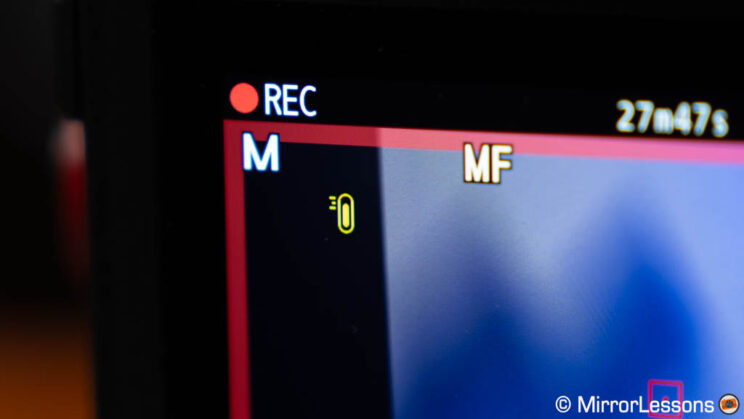
The A1 managed just over an hour in 8K before the camera shut down because of too high internal temperature (the warning on the display appeared 56 minutes in). In 4K 25p however, the Sony only stopped because the battery ran out (almost two hours).
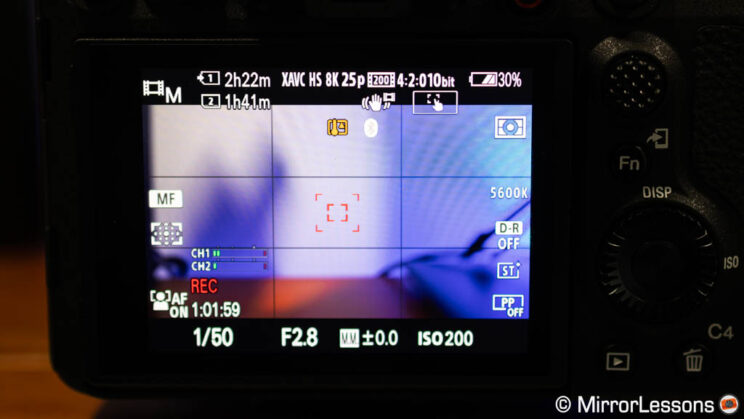
Both cameras have an option to extend recording with high internal temperatures (which is what I did), although they are not foolproof. If it becomes too hot, they will stop. My testing conditions were at room temperature (20°C), so results may differ in warmer locations.
Extra Features
I’ll be brief here, but in case you’re curious, here is a list of extra features that both cameras have in common:
- Flicker Reduction: Minimizes flickering caused by some artificial light sources that operate at 100Hz or 120Hz.
- High-Frequency Flicker Reduction: More advanced than the previous option, it allows you to adjust the shutter speed in more precise increments to reduce or eliminate flickering. Unlike the standard Flicker Reduction, this feature works with the electronic shutter and for video. On the A1, it is referred to as ‘Variable Shutter.’
- Interval Timer: Capture photos at set intervals to create time-lapse compilations. The Z8 also offers the option to save a video file in-camera.
- Bracketing: Capture a set number of pictures while automatically varying the exposure. Both cameras can also do the same for flash level, Active D-Lighting (DRO for the A1), and white balance.
- Wireless Connectivity: Connect to smart devices via Wi-Fi and Bluetooth to transfer files, geotag your images, or remotely control the cameras. You can also transfer photos to an FTP server.
- Voice Memos: Save a brief audio recording for a specific photograph. This is very useful for adding notes on the fly.
The Z8 comes with a few additional features:
- HDR Overlay: Merges two photos taken with different exposures to increase the amount of details in the shadows and highlights (JPG only).
- Focus Shift Shooting: Also known as focus bracketing, the camera captures a set number of frames while varying the focus point in-between. This feature is primarily used by landscape or macro photographers. The images must be stacked in post.
- High-Res Zoom: Record a video while digitally zooming the image. You can choose from three levels of zoom speed.
- Inter-camera Connection: Link up to 10 compatible Nikon cameras and trigger the shutter of all of them simultaneously using ‘Synchronized Release.’ You can also synchronize the internal clock on all linked models.
Price and Lens System
The most significant difference between these two cameras is the price.
The Nikon Z8 can be purchased at a retail price of $4,000, £4,000, or €4,600 (body only).
On the other hand, the Sony A1 is more expensive, starting at $6,500, £5,880, or €7,300.
Note: Prices are as of October 2023.
Sony initiated the full-frame E-mount series in late 2013, while Nikon entered the full-frame mirrorless market in 2018. This gap allowed Sony to build a large catalog of lenses, and from the start, it licensed the E-mount to third parties.
Today, there are nearly 130 full frame lenses designed specifically for the E-mount by Sony, Sigma, Tamron, Zeiss, Samyang, Tokina, and Viltrox. And this list only includes autofocus lenses. The catalog expands further when considering native APS-C lenses, a wide range of manual focus lenses, and the adaptability of DSLR and rangefinder lenses to the A1, facilitated by the numerous adapters available in the market. It’s indeed a comprehensive system today, and Sony has begun updating some of its lenses already (e.g., the excellent second-generation F2.8 zoom trio).
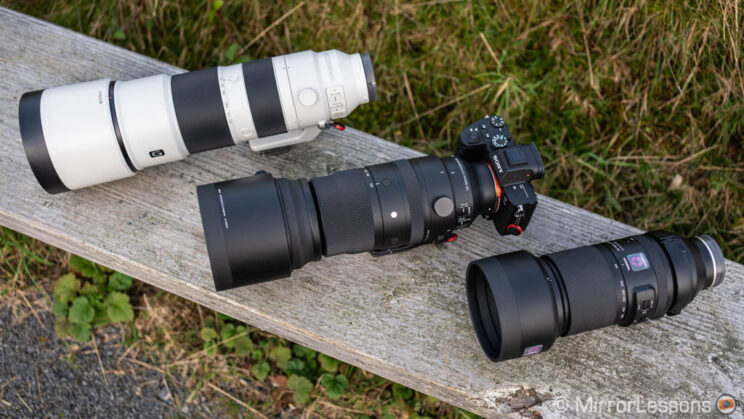
At the time of publishing, Nikon has made 38 native Z-mount lenses available for the Z8, in addition to two teleconverters. The selection comprises various zooms suitable for amateurs and professionals, including affordable F2.8 zooms. Compact primes and standout lenses, such as the F1.2 and F0.95, are also available.
Nikon’s strength, in my opinion, lies in its long telephoto lenses. Alongside products like the recent 180-600mm F5.6-6.3, the company offers enticing options such as the compact and lightweight 400mm F4.5 and 600mm F6.3. The 400mm F2.8 comes with a built-in extender, and the 800mm F6.3 is much lighter and more compact compared to its older DSLR counterpart. However, it’s worth noting that many of these lenses are on the expensive side. Nevertheless, Nikon is providing wildlife photographers with a wide range of choices between zooms and primes, more than what Sony offers at the moment.
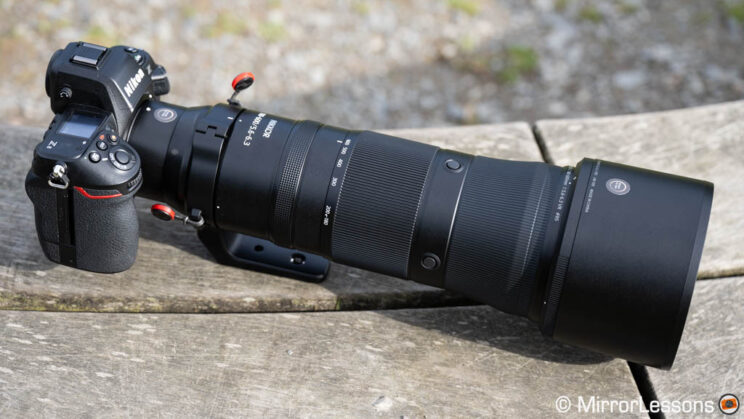
Furthermore, Nikon has started licensing the Z-mount to third-party manufacturers, and we are seeing the first lenses from Sigma and Tamron being released (they have the same optical design as the Sony versions, but with the electronics adapted to the Z-mount). While the system still lags behind what’s available for Sony users, this is an encouraging sign.
Of course, many Nikon users transitioning from DSLRs can take advantage of the FTZ adapter to use their F-mount lenses on the Z8. This setup works really well, and there are invaluable items in the DSLR category, such as the 500mm F5.6 PF lens. Nikon has even introduced a new version of its adapter, the FTZ II.
Conclusion
You may have read this article out of curiosity rather than having a real dilemma in choosing one of these two models. But since you made the effort, do you think there is one camera that really stands out?
For sure, the first thing that catches your eye is the price: the two products share many similarities, yet sit in separate categories when it comes to their target audience, and the difference in cost when buying one or the other is significant. The Z8 is a smaller and more affordable version of the flagship Z9, while the A1 represents the pinnacle of the E-mount system.
What I appreciate about the Z8 is how it demonstrates the significant strides Nikon has made to reclaim a prominent position and compete on even ground with Sony and Canon. The company was initially hesitant to embrace the potential of mirrorless cameras (they even disliked the term ‘mirrorless’), dedicating too much effort to the 1 series, an intriguing concept that was ahead of its time initially and became outdated rather quickly. Even when the Z series was introduced, it took Nikon some time to come-up with something genuinely groundbreaking.
But all of that is in the past. Today, Nikon has produced what I consider one of the best mirrorless cameras ever made: it boasts superior ergonomics, serious autofocus capabilities, stunning continuous shooting speed, great image quality and impressive video performance. It is a perfect representation of the company’s past and future: the Z8 combines all the fantastic elements that Nikon has honed over the years with its DSLR cameras, blending them with new generation state-of-the-art technology.
I also find it intriguing to see Nikon, a company with less history than others in the realm of professional video cameras, offering functions that Sony has yet to include in its products. Sony, of course, sells cinema cameras and camcorders, and may leave a few features out to avoid a conflict of interest, whereas perhaps Nikon can allow itself to be bolder with its choices in this department.
The A1 is older, which means it misses some of the latest updates Sony has incorporated into its more recent models. Nevertheless, it remains the best mirrorless camera I’ve ever tested when it comes to autofocus. When it was released in 2021, it instantly claimed the crown, with only other Sony models like the A9 series as contenders. Since then, Nikon and Canon have closed the gap, perhaps to the point where the minor differences no longer matter, but the A1 is still the camera to beat when it comes to AF. It also offers a bit more in terms of image quality for photos, can do 30fps with RAW, and while its video capabilities may not include internal RAW recording, the 8K footage is stunning and 4K 120p provides sharper results.
What the A1 lacks are more firmware updates. Sony has introduced new functions and features that could easily be integrated into the flagship camera, but its recent track record with software updates is disappointing. I sincerely hope that will change in the future. Providing regular updates is one of the best ways to keep customers satisfied. Fujifilm has set a great example in the field, and other brands have followed suit, including Nikon, which has done a remarkable job with the first-generation Z6 and Z7, as well as the Z9. I hope they continue this trend with the Z8 as well.
Reminder: the links below are affiliate links. If you decided to buy something after clicking the link, we will receive a small commission.

